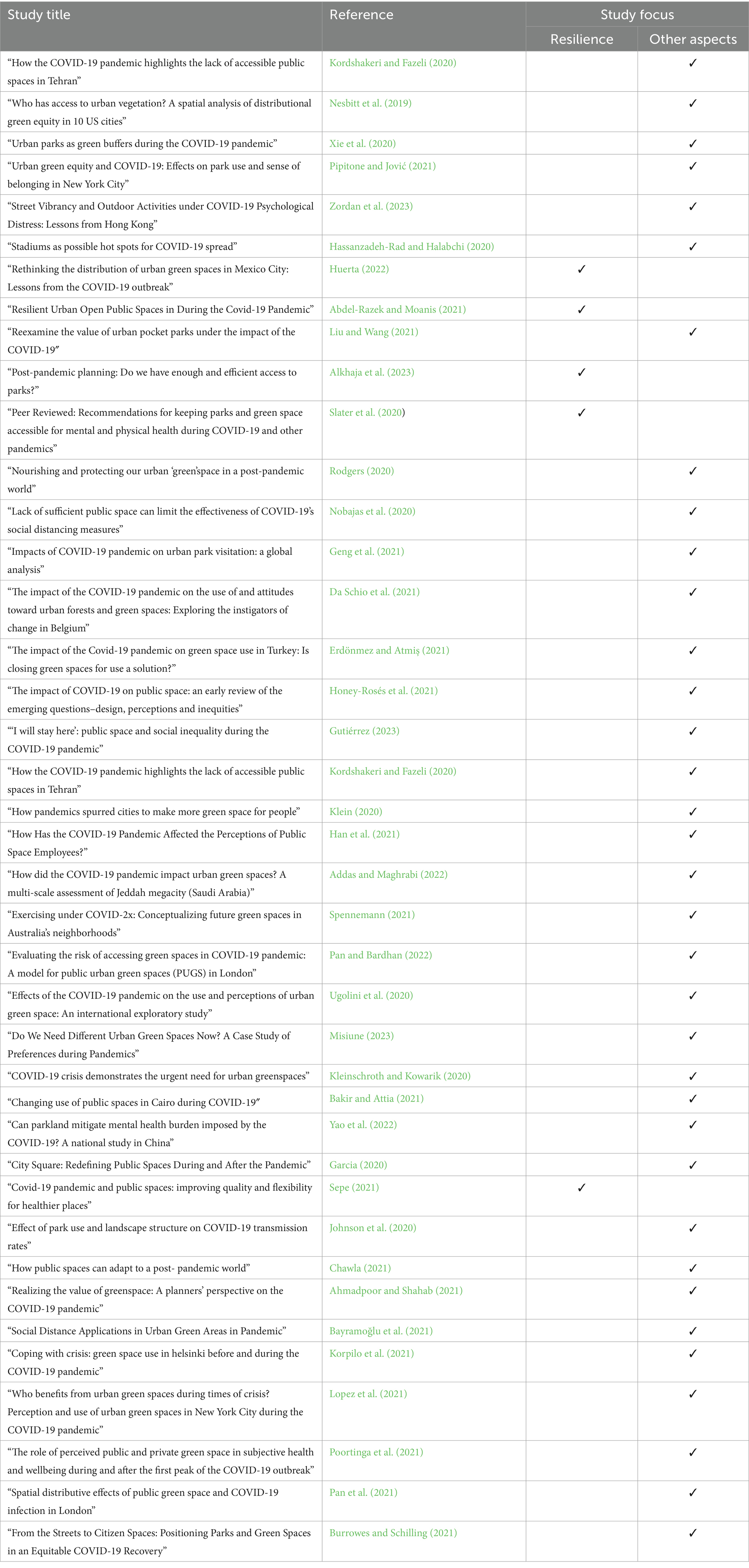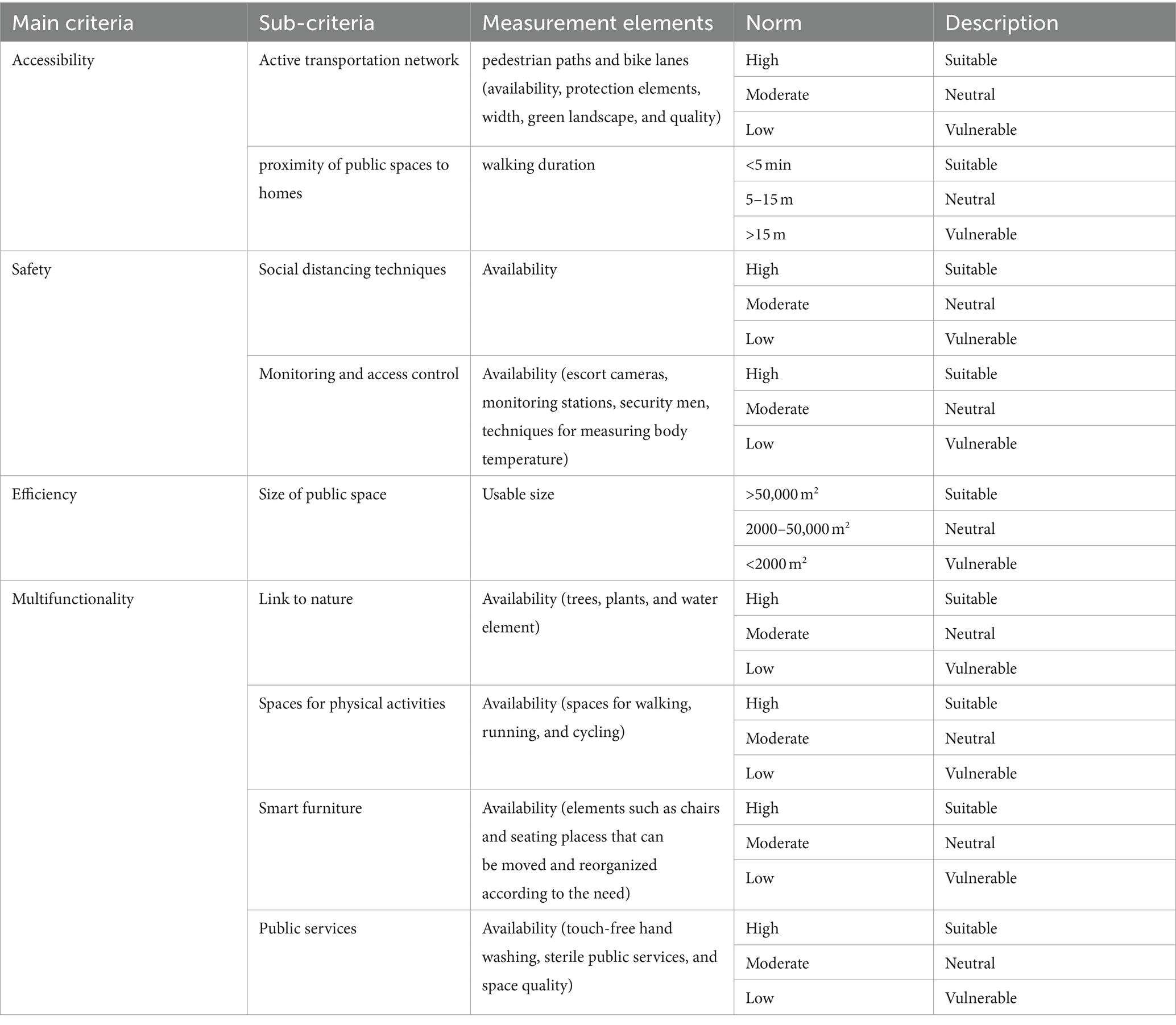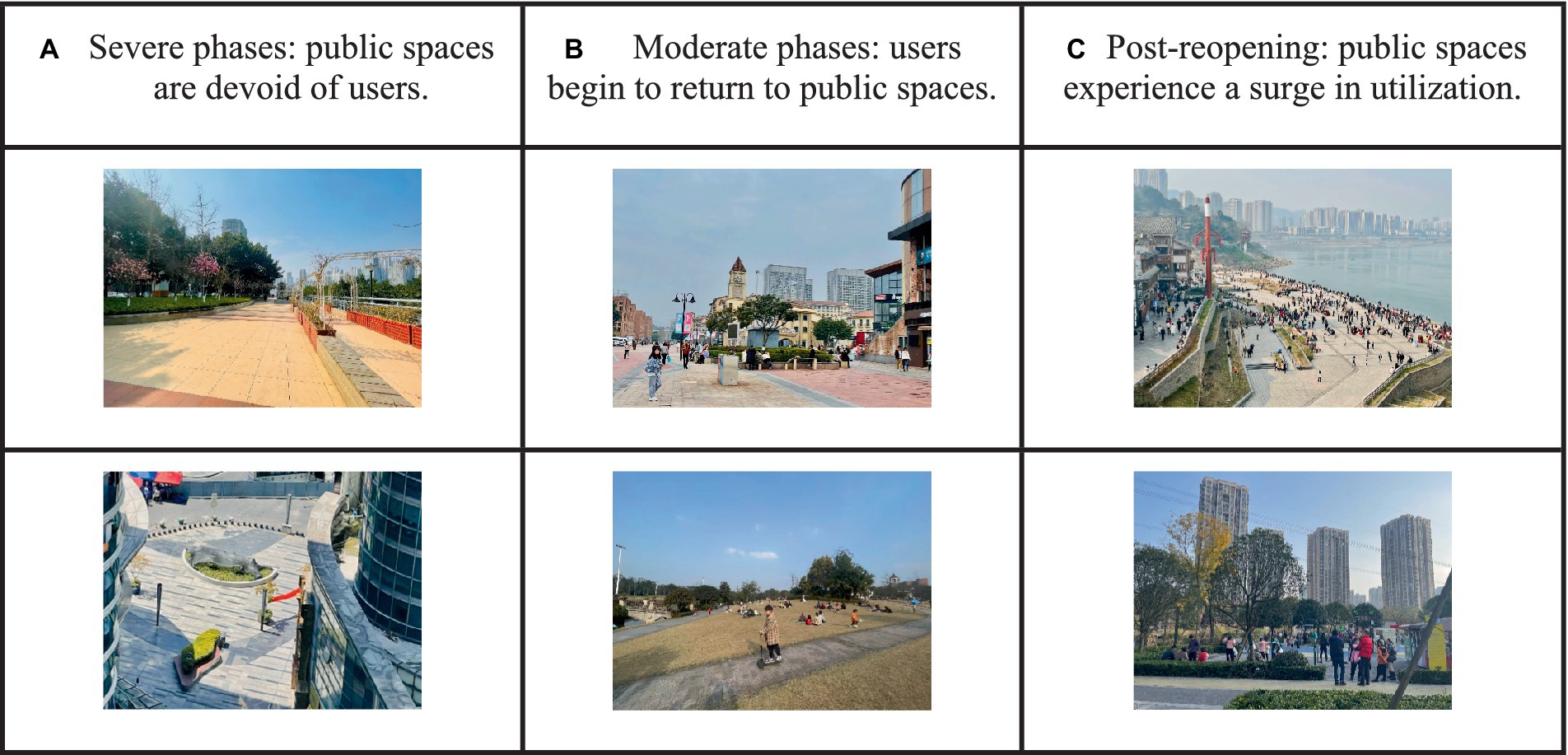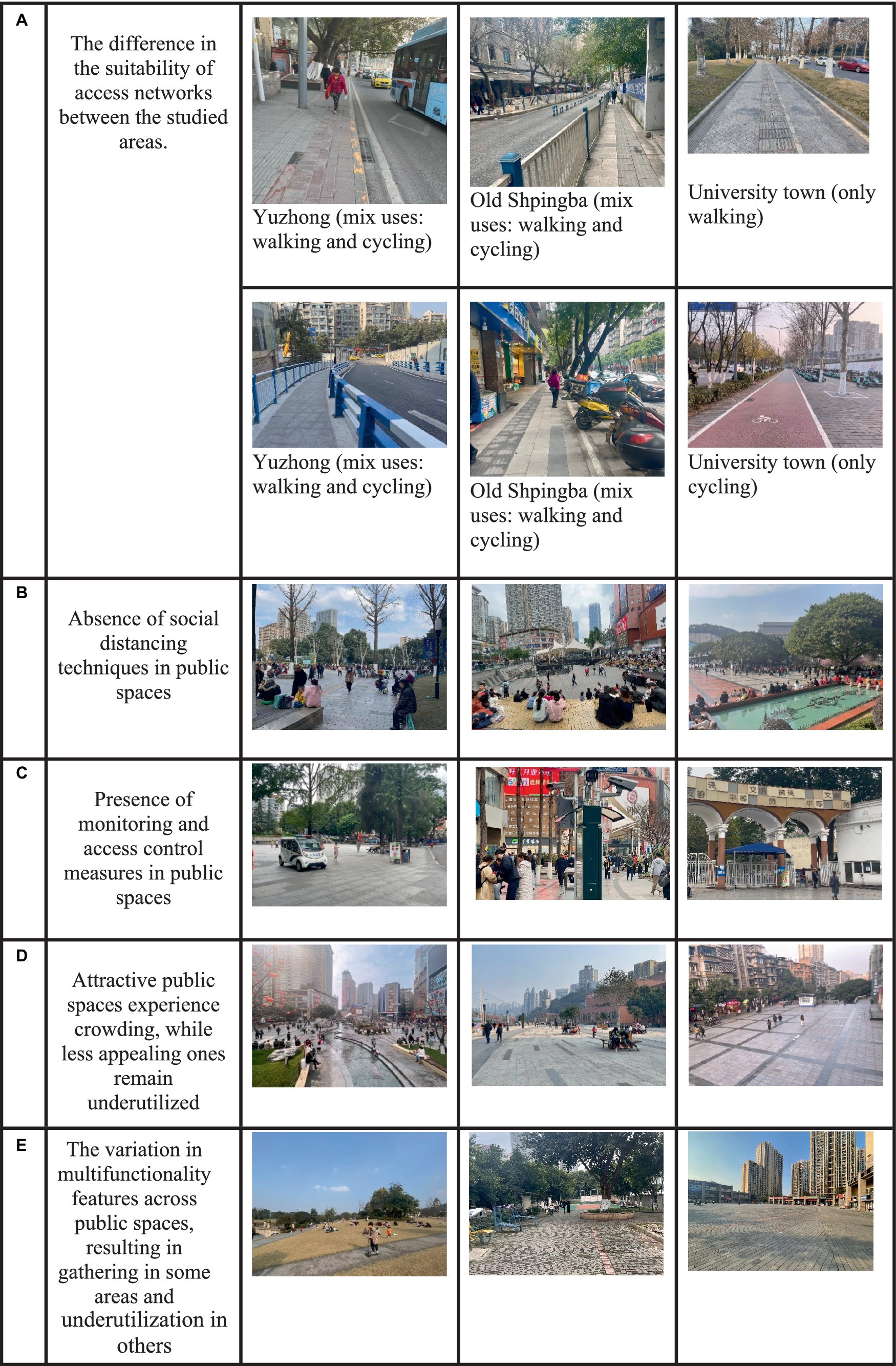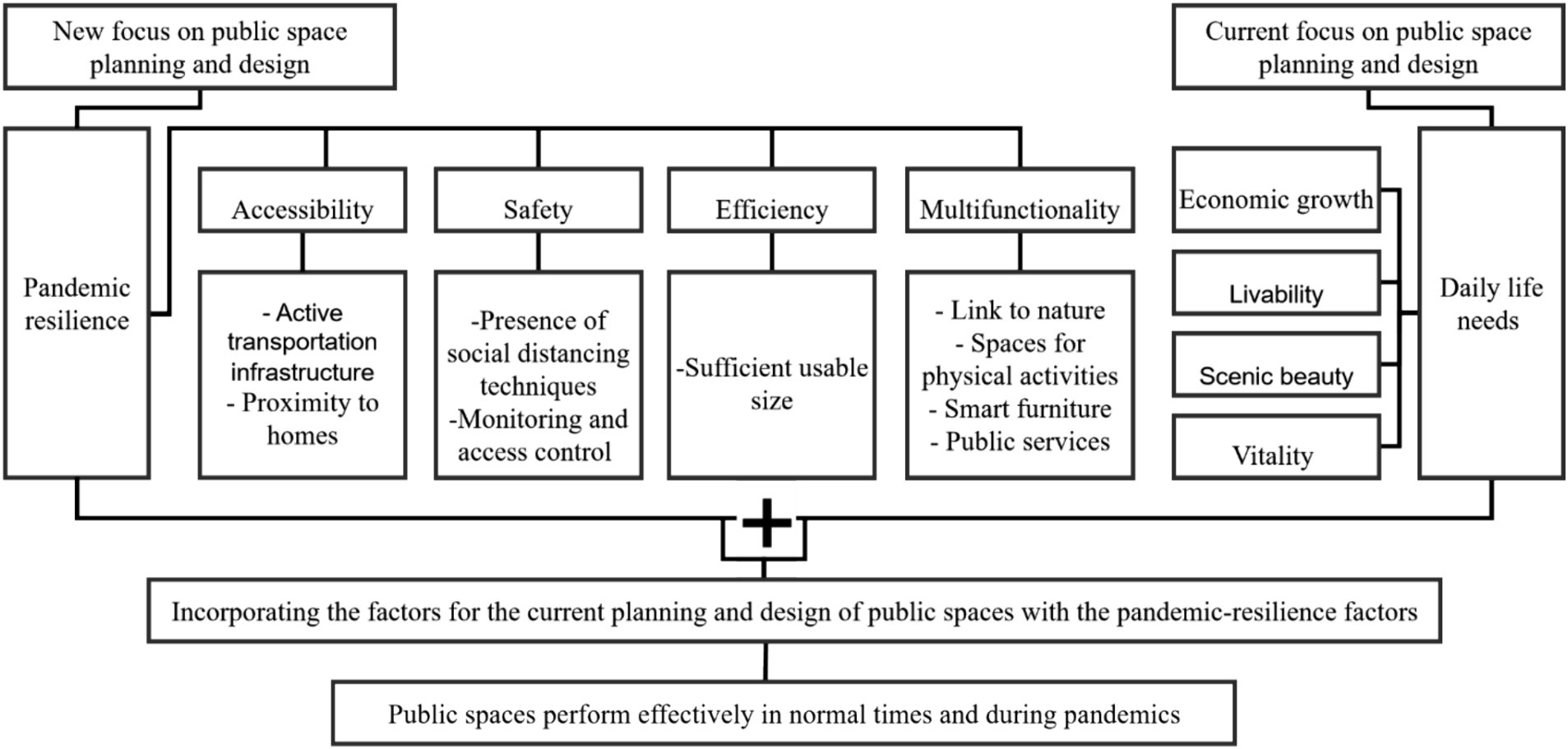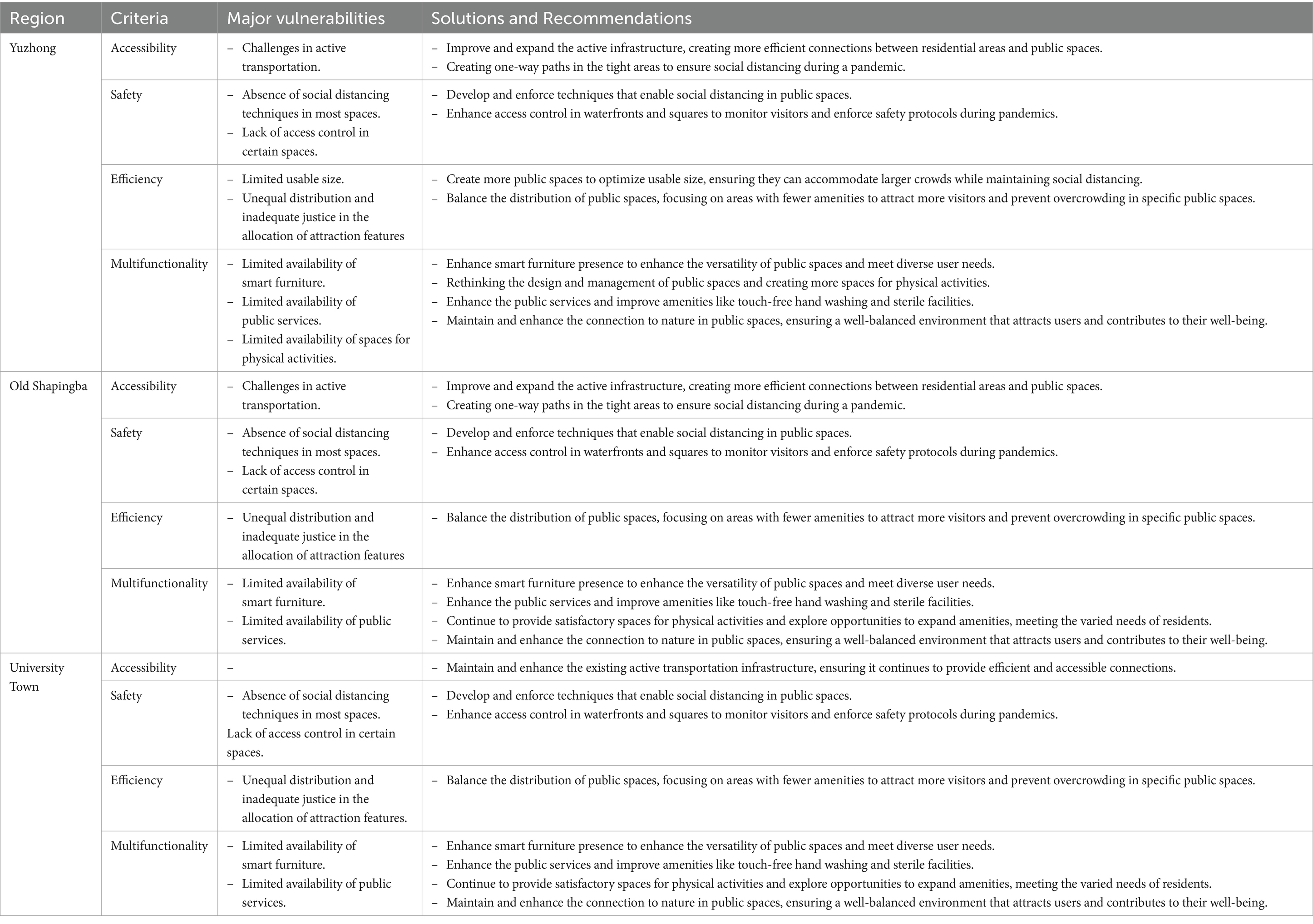- School of Architecture and Urban Planning, Chongqing University, Chongqing, China
The COVID-19 pandemic emphasized the importance of public spaces. Accessing public spaces during the pandemic improves physical health, reduces feelings of loneliness, and lessens depression. However, not all public spaces can provide an effective response during the pandemic. The public spaces’ ability to respond to the pandemic varies depending on their resilience level, which refers to the capability of those spaces to adapt to the challenges posed by the COVID-19 pandemic and maintain functionality to meet users’ needs during this crisis. By investigating the response of existing public spaces to the COVID-19 pandemic and identifying and examining the criteria of pandemic resilience, this study aims to explore and improve public spaces’ capability to respond effectively during the pandemic. One hundred and sixty nine public spaces in three regions in Chongqing City in China are studied. Four main criteria involving 9 sub-criteria of pandemic resilience that can be integrated into public spaces’ planning and design are studied. Three questionnaire surveys are used in this study to examine how public spaces adapt to the pandemic and evaluate the pandemic resilience criteria. The questionnaire data is analyzed using the Statistical Package for Social Sciences (SPSS) software. The pandemic resilience criteria are assessed and analyzed using a Geographic Information System (GIS). The study utilized the analytic hierarchy process (AHP) to assign weights to the criteria of pandemic resilience. Weighted overlay analysis (WOA) is applied to assess the pandemic resilience level in public spaces. Results indicate various possibilities for pandemic resilience depending on the characteristics of the area. However, these resilience levels are inadequate to respond effectively to the pandemic, resulting in diminished utilization of public spaces during the COVID-19 pandemic across all studied regions compared to the periods preceding the pandemic and after the complete reopening. This study presents a remarkable source for strengthening the resilience of cities against pandemic emergencies.
1 Introduction
Most of the global population now resides in urban areas, with over half of the planet’s inhabitants currently living there (United Nations, 2018). Cities serve as magnets for individuals seeking business opportunities and innovation. However, they also represent areas vulnerable to sudden stresses or shocks, which can precipitate social, physical, or economic collapse (Sharifi et al., 2021). Despite their historical resilience in the face of challenges such as resource scarcity, natural disasters, and conflicts, the 21st century presents new and escalating threats to urban environments, including pandemics, terrorism, and climate change. This escalation is fueled by the rapid growth of urban populations (ResilienceIndex, 2014).
Diseases pose one of the most severe threats to human life and global economies. In recent decades, the world has witnessed an increase in the number of new infectious diseases that have had an impact not only on the health sector, but also on the urban environment and the economy (Eltarabily and Elghezanwy, 2020), including Severe acute respiratory syndrome (SARS), Ebola virus disease (EVD), Middle-East respiratory syndrome (MERS), Avian influenza (Lancet, 2020), and lately, the COVID-19 outbreak that has emerged by the end of 2019 in Wuhan City in China; then, it spread during the following months to infect most of the world cities. By the end of January 2024, the Corona pandemic had taken the lives of more than 6.97 million people and afflicted over 702 million individuals (Meter, 2024).
The COVID-19 pandemic underscored the profound significance of public spaces. Studies show that accessing public spaces during the pandemic improves physical health, relieves stress, reduces feelings of loneliness, and lessens depression (Soga et al., 2021; Spennemann, 2021; Hohl and Lotfata, 2022). Conversely, restricted access to public spaces during the pandemic has been connected to adverse effects on individuals’ physical and psychological well-being, with implications for cognitive abilities, depression and stress, academic achievement, physical activity, weight gain (Husky et al., 2020; Wang et al., 2020), and increase in incidents of domestic abuse (Silverio-Murillo et al., 2020). It also largely affects vulnerable populations such as those with respiratory impairment, recovering from cancer, immunocompromised, the elderly, people with comorbidities, and those with potentially worsening health conditions (Slater et al., 2020). However, due to the restrictions implemented by numerous countries to limit the pandemic spread, public space usage has been severely affected (Tareke, 2023), preventing people from enjoying the benefits of public spaces during this challenging time.
Given the profound importance of public spaces during the pandemic and to improve their response to the pandemic and avoid their closure and usage restriction, resilience becomes paramount. Resilience holds various meanings in academia, contingent on the aspect or domain under investigation (Ribeiro and Gonçalves, 2019; Alawneh and Rashid, 2022; Mengistu et al., 2022; Sharifi, 2023). Pandemic disaster resilience, in particular, refers to the urban environment’s ability to resist a blow without considerable structural or functional alterations (Zhou et al., 2020). In this context, the concept of “disaster resilience” has recently gained prominence in urban contexts (Sharifi, 2020), and the notion of a “disaster-resilient city” is increasingly featured in institutional policy documents and disaster management studies (Alawi et al., 2023).
The significance of public spaces during the COVID-19 pandemic, the pandemic’s impact on public space usage, and the necessity for pandemic resilience underscore the urgent need for this study. This research aims to establish resilient public spaces capable of effectively responding to the pandemic by addressing the following inquiries: Q1: How did the existing public spaces respond to the COVID-19 pandemic? Q2. How can the pandemic resilience in public spaces be examined to explore and enhance their capability to respond effectively during the pandemic?
This study explores the response of existing public spaces in Chongqing to the COVID-19 pandemic by examining the impact of the pandemic on daily public space utilization before, during, and after the outbreak (following the announcement of the complete reopening policy in China on January 8, 2023). Additionally, it investigates pandemic resilience in public spaces by developing and analyzing four primary resilience criteria: accessibility, safety, efficiency, and multifunctionality. The study assesses the response of current public spaces to the COVID-19 pandemic and evaluates pandemic resilience criteria in 169 public spaces, including squares, public parks, sports fields, waterfronts, and residential block parks in three regions of Chongqing City, China (43 public spaces in the Yuzhong region, 61 public spaces in the old Shapingba region, and 65 public spaces in the University town region).
This study’s novelty lies in its detailed examination of the COVID-19 pandemic’s impact on the daily use of public spaces, marking the first such investigation in Chongqing. Furthermore, it delves into the vulnerability of existing public space networks to the pandemic and integrates pandemic resilience into public space planning and design, thereby creating public spaces that perform effectively whether the situation is normal or in a pandemic emergency. This study serves as a significant resource for decision-makers, architects, and planners, enabling them to create pandemic-resilient public spaces, thereby mitigating the pandemic’s effects and losses and enhancing the resilience and sustainability of communities.
The remainder of this paper is arranged in the following order: The second section provides a literature review connected to the study topic. This section consists of three parts. The first part explains the need for public spaces during the pandemic. The second part explores the effect of the COVID-19 pandemic response policies on public spaces. The third part explains the need for resilient urban planning and design as a solution to cope with the pandemic in public spaces. The third section describes the study’s materials and methods. This section consists of four parts. The first part presents the study area (Chongqing City) and the three regions of the research: Yuzhong, old Shapingba, and University town. The second part elaborates on the dimensions utilized in this study to examine the impact of the COVID-19 pandemic on existing public spaces. The third part develops the pandemic resilience criteria that could be incorporated into the planning and design process of public spaces. The fourth part explains the methods of the study.The fourth section shows and assesses the results of the study. It consists of four parts. The first part evaluates the impact of the COVID-19 pandemic on the existing public spaces in Chongqing. The second part assesses the COVID-19 pandemic resilience criteria in public spaces. The third part determines the pandemic resilience level of public spaces. The fourth part provides solutions and recommendations for improving the pandemic resilience in public spaces. The fifth section includes the study conclusion. The sixth section presents the limitations of the study and recommendations for future research.
2 Literature review
2.1 The need for public spaces during the pandemic
The COVID-19 pandemic underscored the significant role of public spaces, a theme explored in numerous studies globally. In China, (Zhu and Xu, 2021) highlighted the significance of public spaces as contributors to well-being. Utilizing a social platform, they analyzed emotions within and surrounding urban public spaces in Beijing. Their results indicated that amid the height of the pandemic, visitors to public spaces produced a greater number of positive microblogs within these areas compared to outside them. They identified landscapes and plants as pivotal elements fostering feelings of positivity. Additionally, (Yang et al., 2021) emphasized the beneficial influence of public spaces on individuals’ health. Their research showed that residents residing in neighborhoods abundant with public green spaces exhibited a lesser reduction in daily physical activity levels compared to those in regions with fewer green spaces. Furthermore, (Ye and Qiu, 2021) employed a landscape ecology methodology in their investigation carried out in Wuhan City. Their results unveiled the advantageous impacts of landscape measurements on regulating contagion spread and accentuated the essential function of public and green spaces in improving community well-being. Moreover, (Yao et al., 2022) conducted a nationwide investigation in China to examine the function of public spaces in alleviating the mental health repercussions of COVID-19. One of their primary discoveries was the favorable influence of public spaces on mental well-being amid crises like the COVID-19 pandemic, helping to alleviate its negative consequences.
Ugolini et al. (2020) conducted a study at a European level, providing some of the earliest insights into the utilization and perception of individuals regarding public spaces during the pandemic. Their research unveiled that urban residents prioritize convenient access to public spaces to engage in vital activities such as nature observation, exercising, and relaxation. A noticeable shift in behavior was observed, with an increasing demand for proximity to public spaces, particularly green spaces. In Turkey, as reported by (Erdönmez and Atmiş, 2021), citizens expressed reluctance toward closing public spaces during the pandemic. Findings from a Turkish survey indicated that the pandemic primarily resulted in psychological challenges rather than physical ones. Moreover, the survey emphasized the importance of easy access to public spaces as a critical factor in mitigating the severity of the pandemic’s effects. In Spain, (Jato-Espino et al., 2022) conducted a spatial statistical study examining the correlation between proximity to green infrastructure and self-reported mental health. Their findings indicated that individuals living in close proximity to green infrastructure reported significantly lower levels of anger, stress, alcohol consumption, medication use, and doctor visits. Additionally, amid the pandemic, public spaces can be repurposed into emergency hospitals to treat individuals infected with the virus, as well as isolation centers and sites for conducting pandemic-related examinations.
The studies above underscore the positive effect of utilizing public spaces on well-being, health, and community resilience amid the pandemic. However, significant changes resulting from the COVID-19 pandemic have transformed cities and urban lifestyles, potentially influencing the utilization of public spaces during this period. This matter will be further explored in part 2.2.
2.2 The effect of the COVID-19 pandemic response policies on public spaces
Despite the significant role of public spaces during the pandemic, as outlined in part 2.1, many local governments worldwide enforced varying degrees of restrictions on public space usage as part of comprehensive response policies to address the pandemic. These measures significantly impacted public space utilization during the pandemic. In the first waves of the pandemic, numerous countries implemented “stay-at-home policies” that limited access to public spaces, imposed strict time constraints on their usage, mandated personal protective measures and social distancing, or even prohibited public space utilization altogether. China, Turkey, Chile, Venezuela, Iran, Hungary (Honey-Rosés et al., 2021), and Switzerland (Kleinschroth and Kowarik, 2020) are among the countries that enforced quarantine policies and restricted access to public spaces.
In some countries like Italy and Spain, while public gatherings were initially prohibited, outdoor sports and walking were permitted. However, this policy shifted due to a sharp increase in positive cases of the virus. Italy subsequently outlawed all forms of exercise and restricted walking to within 200 meters from one’s residence; leaving home was only permitted for essential reasons. Similarly, in Spain, a ban on visiting public spaces was enforced on March 14, 2020, as part of the strictest set of restrictions, allowing outdoor activities only for essential purposes (Ugolini et al., 2020).
In the Netherlands, despite the quarantine measures enforced beginning December 24, 2020, regulations permitted a maximum of two individuals to engage in sports outdoors while adhering to a minimum distance of 1.5 meters from each other. Individuals under 18 years old were allowed to take part in outdoor sports activities, granted they maintained the required 1.5-meter distance (Nu Nl, 2020).
In Croatia, Lithuania, and Slovenia, outdoor pursuits remained allowable during the entire duration of pandemic restrictions. However, strict warnings were issued to maintain a safe distance from other individuals and to avoid gatherings of any size (Ugolini et al., 2020).
Contrarily, certain countries refrained from enforcing restrictions on the utilization of public spaces. For instance, notwithstanding curfew measures implemented in numerous countries such as the Philippines, the United States, France, Germany, Austria, and England, public spaces remained accessible (Turkish, 2020).
On the other hand, following the relaxation of pandemic restrictions and the resumption of public space usage, the pandemic’s impact persisted. Several studies have indicated a decrease in the public spaces’ utilization after easing the pandemic restrictions (Nelson Grima et al., 2020; Xie et al., 2020; Addas and Maghrabi, 2022).
In this context, policy measures enacted to deal with the COVID-19 pandemic have resulted in unequal or discriminatory access to public spaces for certain demographic groups. The literature indicates that access to public spaces is unevenly distributed, particularly in cities, contributing to social and environmental inequality (Haase, 2020; Simon, 2020; Honey-Rosés et al., 2021). Vulnerable groups are more severely impacted by COVID-19 due to their restricted access to public spaces (Honey-Rosés et al., 2021). A study conducted by (England, 2020) revealed that a third of the surveyed respondents had not visited any natural spaces for 2 weeks. These findings are associated with the socioeconomic status of the participants: individuals living alone or in high-deprivation areas, those with low incomes or education levels, or the unemployed were less likely to frequent public spaces.
The studies above indicate that COVID-19 response policies have significantly altered public space usage globally, leading to the underutilization of public spaces during the pandemic. Given the substantial importance of public spaces during such crises, resilient urban planning and design have become imperative to enhance their response while mitigating closures and usage restrictions. This aspect will be discussed in detail in the following part.
2.3 Resilient urban planning and design as a solution to cope with the pandemic in public spaces
This study posits that resilience is pivotal in addressing the difficulties posed by the Covid-19 pandemic in public spaces. In light of this, urban planning and design possess the capability to highly participate in establishing resilient disaster cities and become an important instrument in limiting the destructive consequences of disasters and reinforcing the resilience of communities owing to its potential to integrate multi-dimensional features that lessen the impacts of disasters. Many recent studies emphasized this importance (Hossain, 2014; Villagra-Islas and Alves, 2016; Covatta and Ikalović, 2022). Moreover, contemporary global accords like the Sendai Framework for Disaster Risk Reduction (2015) (UNISDR, 2015), the Hyogo Framework for Action (2005) (UNISDR, 2005), and the 2030 Agenda for Sustainable Development (2015) (United Nations, 2015) have stressed the significance of integrating resilience strengthening and reducing disaster risk into the processes of urban planning and design.
Integrating pandemic disaster resilience into public space planning and design can significantly contribute to effective recovery and mitigate the pandemic’s impact. However, current research places relatively little emphasis on resilient planning and designing public spaces for pandemics. Most studies on public spaces during pandemics primarily focus on their importance and the pandemic’s impact on their usage, with only a handful considering public space resilience for pandemics (refer to Table 1). Nonetheless, these studies generally lack clear practical guidance on how to plan and design resilient public spaces to address pandemics. Instead, they underscore the importance of public spaces being resilient for future pandemics and advocate for changes in public space design and planning. For instance, (Huerta, 2022) underscored the importance of rethinking the distribution of public green spaces to ensure universal access during future pandemics. Alkhaja et al. (2023) explored the significance of ensuring efficient access to parks in future planning to optimize their use during pandemics. Abdel-Razek and Moanis (2021) highlighted the necessity for urban design to prioritize health and well-being in public spaces through resilient urban design strategies.
Within this context, the COVID-19 pandemic is unlikely to be the last global health crisis, and thus far, accurately forecasting the timing of such diseases has proven challenging. Consequently, there is increasing pressure on urban planners, engineers, architects, and authorities to enhance the resilience of cities to pandemics. There is an urgent need to devote more attention to creating resilient cities capable of withstanding the impacts of pandemics. This entails conducting further studies on measuring urban areas’ resilience to disease outbreaks, enhancing governance, and integrating physical design and planning into the built environment.
In this regard, by developing pandemic resilience criteria that can be integrated into the planning and design of public spaces (refer to part 3.3) and conducting a practical study to examine and evaluate the level of pandemic resilience in public spaces, this study provides a valuable resource for decision-makers, planners, and designers seeking to create pandemic-resilient public spaces.
3 Materials and methods
3.1 Study area and research sites
3.1.1 Chongqing and COVID-19 pandemic
The case study was carried out in Chongqing City, located in the southwestern part of China (see Figure 1 top part). Chongqing is the largest city in the southwestern part of China and is considered China’s most famous mountainous city. It has an area of approximately 82,400 square kilometers and a population of over 30 million (Statistics CMBO, 2021).
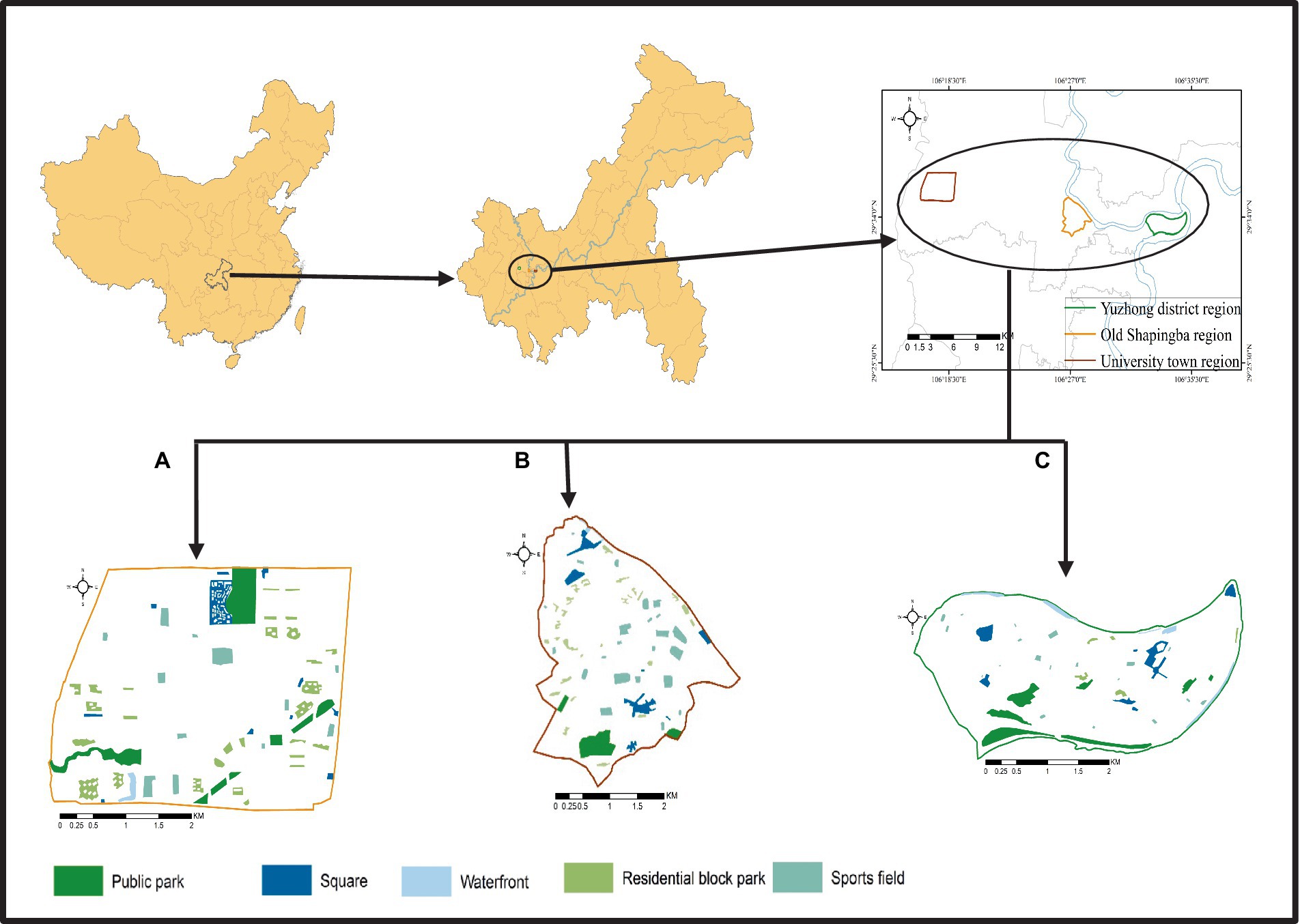
Figure 1. Studied regions’ location (top part) and their public spaces type: (A) University town region; (B) Old Shapingba region; (C) Yuzhong region.
Chongqing, similar to other cities in China and many cities in the world, was affected by the COVID-19 pandemic, which spread to the municipality quickly due to its geographical location near Wuhan, the city where the pandemic appeared for the first time. The first confirmed case of the COVID-19 pandemic appeared in Chongqing on February 5, 2020. Then, the Chongqing Municipality announced the complete closure of the municipality, including public spaces, on February 20, 2020; the closure continued until May 5 of the same year, after ensuring containment of the pandemic. After reopening the city, residents could go to public spaces with the need to adhere to health measures to prevent infection. By the end of 2022, Chongqing had recorded an excess of 80,000 pandemic cases spread across its various districts (Network, 2022). Chongqing was selected as a case study area due to its significance in understanding urban public space resilience. The city’s high population density and complex topography render it vulnerable to various disasters, including pandemics. Furthermore, the absence of prior research on public space response to pandemics in Chongqing underscores the importance of investigating this topic within the city’s context.
3.1.2 Research sites
Owing to the complex characteristics of Chongqing that vary from one area to another, the study was keen to choose three urban sites with different characteristics (central mountainous region, ancient mountainous region, and modern flat region) to gain a comprehensive understanding of the city’s overall traits and explore the impact of the area characteristics on the public spaces’ pandemic resilience and thus on the response to the pandemic. The three selected regions are detailed below,:
• Yuzhong region (Central mountainous region)
Yuzhong District is the center of Chongqing City and the city’s main economic and recreational center. It is situated on a peninsula formed by the intersection of the Jialing and Yangtze Rivers.
The studied region is located in the main area of the Yuzhong District, connected to the region of the intersection of the two rivers (see Figure 1C). It has a population of approximately 377,613 people and a population density averaging nearly 50,348 people /km2, as per the 2020 statistics (Statistics YDBO, 2021).
• Old Shapingba region (Ancient mountainous region)
Shapingba District is located in the southwestern part of Chongqing City. It is a typical mountainous district, dissected by the Jialing River with generally beautiful views, which show a mixture of low mountains, hills, and terraces.
The old Shapingba part chosen in this research is located on the western side of the Jialing River (see Figure 1B). It has an estimated population of around 213,134 residents, with a density averaging nearly 27,324 people /km2, as per the 2020 statistics (Statistics SDBO, 2021).
• University town region (Modern flat region)
University town is an open and relatively flat area with wide streets when compared with the rest of Chongqing and can be considered one of the choicest flat regions in Chongqing. According to the latest plan, a part of the University town becomes under the authority of High Technology (Direct Management Park), while the other part belongs to the Shapingba District.
The studied region of the University town is situated in the part belonging to the Shapingba District (see Figure 1A) with a population of nearly 186,449 people, and an average density of roughly 17,263 people /km2, as per the 2020 statistics (Statistics SDBO, 2021).
3.2 The impact of the COVID-19 pandemic on the existing public spaces
The study investigated the impact of the COVID-19 pandemic on the existing public spaces from three dimensions. Firstly, it examined the impact of the COVID-19 pandemic on public spaces during severe phases of the pandemic. This involved examining how the pandemic affected public spaces during periods of high severity. It encompasses the first period of the pandemic in Chongqing, which witnessed a complete lockdown from February 5, 2020, until May 5, 2020, as well as other short severe waves that led to complete lockdowns in the studied areas throughout the three-year period of pandemic management (2020, 2021, and, 2022). Second, it investigated the impact of the COVID-19 pandemic on public spaces during moderate phases of the pandemic. This focused on understanding how the pandemic influenced the utilization of public spaces during moderate phases. It covers the period following the relaxation of pandemic restrictions and the cessation of citywide lockdowns, during which public space usage was permitted while adhering to pandemic-related constraints. This period spans from May 6, 2020, to January 8, 2023, excluding the short severe periods that experienced complete lockdowns within this timeframe. Lastly, the study examined the impact of the COVID-19 pandemic on public spaces after the complete reopening of China and the cessation of the pandemic restrictions. This aspect involved studying the utilization of public spaces after the complete removal of all pandemic-related restrictions and the declaration of China’s full reopening. This phase encompasses the period after January 8, 2023.
3.3 The criteria for pandemic-resilient public spaces
3.3.1 Accessibility
Accessibility is a fundamental urban concept that describes how easy it is to get to any given area (Verma et al., 2019).
The emergency resilience of an access network is identified as the capability of the access network infrastructure to keep the functionality or minimize the effect after a disturbance. In addition, the system needs to be capable of bouncing back from setbacks or adjusting to new circumstances (Zhang et al., 2015; Aghababaei et al., 2021; Mason and Brabhaharan, 2021).
During the COVID-19 outbreak, the Centers for Disease Control (CDC) has suggested people utilize types of transportation that reduce close contact with each other, like walking and cycling (Prevention CFDC, 2021). At the same time, the World Health Organization (WHO) recommends walking or cycling as they are less at risk of contracting SARS-CoV-2, apart from their crucial role in raising the life quality in cities (World Health Organization, 2022). In this regard, ensuring equity in the availability and quality of access networks (walking paths and cycling lanes) (Macioszek and Granà, 2021; Macioszek et al., 2023) is a major consideration for ensuring resilience to pandemics in public spaces. The presence of equitable and efficient access to public spaces improves the ability of the community to withstand and recover from a pandemic (Gutiérrez, 2023).
Accessibility can be measured through different methods. The access network characteristics are crucial aspects that should be considered when measuring accessibility. Proximity is another important factor for measuring accessibility to public spaces (Logan and Guikema, 2020).
Accessibility in this study refers to easy and safe physical reaching to public spaces within a short period of walking or cycling, considering the pandemic measures. Two sub-criteria determine accessibility in this study: active transportation network (pedestrian paths and bike lanes connecting users’ homes to public spaces) and the proximity of public spaces to homes (Table 2).
3.3.2 Safety
Safety is considered a major priority in public spaces during pandemics. The COVID-19 pandemic has revealed difficulties in safety standards in public spaces. The utilization of public spaces by large crowds can potentially elevate the risk of disease transmission (Mehta, 2020). Therefore, some public health strategies have recently emerged to reduce the possibility of disease transmission in public spaces through individual and community approaches. Major individual actions include wearing masks (Ding and Zhang, 2022) and staying at least 1 meter away from other individuals and paying attention to the etiquette of respiratory reflexes, such as sneezing or coughing into a tissue or elbow (Canada PHAO, 2020). On the other hand, the community-based approaches have comprised preventive closures and limitations on activities and access. However, closing and restrictions on the utilization of public spaces reduce the opportunities to practice healthful outdoor activities and stress alleviation. This scenario may drive users to choose less appropriate and more crowded spaces.
Accordingly, to ensure safety in public spaces during the pandemic, public spaces should be provided with health and safety techniques and regulations (Arafat et al., 2021). Public spaces should be provided with some facilities, such as social distancing markers, temperature check facilities (Arafat et al., 2021), security men, escort cameras, monitoring stations (Zavadskas et al., 2019), and the presence of emergency stations (Gallerani et al., 2017).
This study assesses safety through two sub-criteria: the social distancing techniques and the monitoring and access control features (Table 2).
3.3.3 Efficiency
Public space effectiveness indicates the capacity of public space to provide sufficient uses. The public spaces’ efficiency in a pandemic emergency means the ability of those spaces to safely and effectively provide sufficient uses for all users during those difficult times. In this regard, the size of the public space is an essential factor in determining the effectiveness of space, especially during pandemics. The COVID-19 pandemic and its health requirements for the prevention of pandemic infection showed the value of the availability of public spaces with sufficient size to meet the users’ needs during the pandemic.
Many academics demonstrate the significance of public space size. According to (Ibes, 2015), the size of public space is crucial due to its effect on the number of people using the space and the kinds of activities they engage in, which increase the variety of human values. Van Herzele and Wiedemann (2003) demonstrate that public space services differ depending on the area’s size. In addition, public space environmental quality and the kind of activities enjoyed there are affected by the space size (Le Texier et al., 2018). Furthermore, the advantages of public space grow in tandem as their size increases (Cetin, 2015).
During the pandemic, while public spaces of all sizes hold significance, larger public spaces are more effective than smaller ones. Several studies indicate the importance of large urban spaces during the pandemic (Nieuwenhuijsen, 2020; Samuelsson et al., 2020b; Honey-Rosés et al., 2021). Large public spaces readily facilitate social distancing, a crucial aspect during the pandemic. Implementing social distancing measures in smaller public spaces poses a challenge, particularly in densely populated regions like Chongqing. Following China’s emergency response norms, spaces with an area size of less than 2000 m2 are considered less efficient during emergencies, while those exceeding 50,000 m2 are highly efficient (China MOHA, 2018).
The public space ratio is the most used indicator for measuring the effectiveness of public spaces (Haq, 2011). It is obtained by calculating the number or surface area of public spaces within a city or parts of it, offering an overview into the quantity of users who can utilize the public space (Nicholls, 2001) and the potential for congestion in the public space (Van Herzele and Wiedemann, 2003; Sister et al., 2010).
This study examines efficiency by measuring the usable size of public spaces in the studied areas and ascertaining their capacity to be used efficiently within the pandemic (Table 2), taking into account that each user needs to keep a 1-meter distance from others (Canada PHAO, 2020). The capacity of public spaces is compared with the area’s population to ascertain the abilities of the existing public spaces to meet the users’ needs during the pandemic.
3.3.4 Multifunctionality
The multifunctionality of urban space is rooted in architecture, urban planning, and design to create varied uses of urban space, which can change over time (Zeidler, 1985). Multifunctionality is an essential part of resilience to pandemics. It is a crucial strategy for making public spaces more responsive to pandemics, where they can change modes of use without changing their nature.
To ensure that public spaces effectively serve multiple functions and meet the diverse needs of users during the pandemic, several key considerations must be taken into account. Firstly, enhancing the quality of public spaces is essential to create inviting and functional environments conducive to various activities while also ensuring compliance with social distancing measures (Sepe, 2021). In addition, integrating elements of nature into public spaces can provide respite and relaxation for individuals amidst the challenges of the pandemic (Garcia, 2020). Additionally, the adaptation of public spaces through innovative solutions such as sterile and contact-free equipment is critical to minimize the risk of virus transmission (Chawla, 2021). Furthermore, the COVID-19 pandemic has underscored the importance of rearranging public spaces to promote physical activity and address barriers to exercise, thereby improving overall health and well-being (McDougall et al., 2021). Moreover, the evolution of multifunctional furniture innovations offers promising opportunities to optimize the use of limited space in public areas, allowing for greater flexibility and efficiency in accommodating diverse activities and user needs (Shaleh et al., 2022).
This study analyses multifunctionality by investigating four sub-criteria that provide multifunctions in public spaces and meet the users’ demands during the pandemic: link to nature, which involves elements such as trees, plants, and water element; spaces for physical activities, which includes spaces for walking, running, and cycling; smart furniture, which includes elements such as chairs and seating placess that can be moved and reorganized according to the need; and public services, which involves aspects such as touch-free hand washing, sterile public services, and space quality (Table 2).
3.4 Research methods
3.4.1 Data collection
The study used the master plan of Chongqing City, satellite images, open street maps, Baidu maps, and field observation to identify the public spaces and their features, comprising the public spaces’ location, proximity to homes, services, usable size, and geographical characteristics.
All studied public spaces were visited to collect data pertaining to the active transportation infrastructure characteristics, the presence of social distancing techniques, monitoring and access control, link to nature, spaces for physical activities, smart furniture, and public services.
Three questionnaire surveys were conducted for this study. The first questionnaire survey targeted residents of the studied areas to examine the extent of the response of public spaces to the COVID-19 pandemic. This involved comparing the usage of public spaces during and before the pandemic, including the number of visits to public spaces, the time the users spend in public spaces during their visits, and the activities performed in public spaces. This questionnaire was conducted between March and September 2022. A total of 1,302 valid questionnaire samples were collected from the three study regions: 442 samples from the Yuzhong region, 463 samples from the old Shapingba region, and 397 samples from the University town region. All studied public spaces were included in this questionnaire.
The second questionnaire also targeted residents of the studied areas to assess the response of public spaces after the complete reopening of China. This survey compared the utilization of public spaces during the pandemic period and after the complete reopening, including the number of weekly visits to public spaces, the time the users spend in public spaces during their visits, and the activities performed in public spaces. This questionnaire was distributed in the three studied regions from March and May 2023. Four hundred thirty-five valid questionnaire samples were collected from the three study regions: 148 samples from the Yuzhong region, 154 samples from the old Shapingba region, and 133 samples from the University town region. All public spaces under study were included in this questionnaire survey.
The third questionnaire was conducted between March and April 2023 to appraise the pandemic resilience criteria of public spaces. One hundred twelve responses were gathered from experts in the urban planning, architecture, and landscape engineering fields. The results of the experts’ evaluation were utilized to determine the criteria weights using the Analytic Hierarchy Process (AHP) presented in the following sub-section.
3.4.2 Data processing and analysis
The questionnaire data were analyzed using the Statistical Package for Social Sciences software (SPSS) version 26. The impact of the COVID-19 pandemic on the existing public spaces was analyzed through the Paired-Samples T-Test.
We used a Geographic Information System (GIS), precisely ArcGIS 10.8.1, to evaluate the pandemic resilience criteria of public spaces. The findings from data analysis were visually depicted through GIS maps.
To evaluate the level of pandemic resilience of public spaces, we utilized a blend of the Analytic Hierarchy Process (AHP) and Weighted Overlay Analysis (WOA).
AHP is a technique developed by Saaty in 1970 (Saaty, 2008) as a method of modeling subjective decision-making processes that consider a number of attributes in a hierarchical framework. Since then, AHP has been widely used in different sectors, including urban planning. It is a clear systematic quantitative analytical tool, which is suitable for the calculation of multiple criteria studies. A literature review and experts’ knowledge determine which criteria take priority over the others when deciding (Rana and Suryanarayana, 2020). De Brito and Evers (2016) state that the AHP approach is the method most commonly utilized in studies involving weight factors. Accordingly, several recent studies on the COVID-19 pandemic utilized the AHP method to calculate the factors’ weight (Das et al., 2021; Ortiz-Barrios et al., 2021; Palouj et al., 2021).
The AHP method was done in this study through four steps: First, the decision problems were organized into three hierarchical levels. The highest level defined the goal, the second level outlined the assessment criteria, and the third level explored the options (Figure 2).
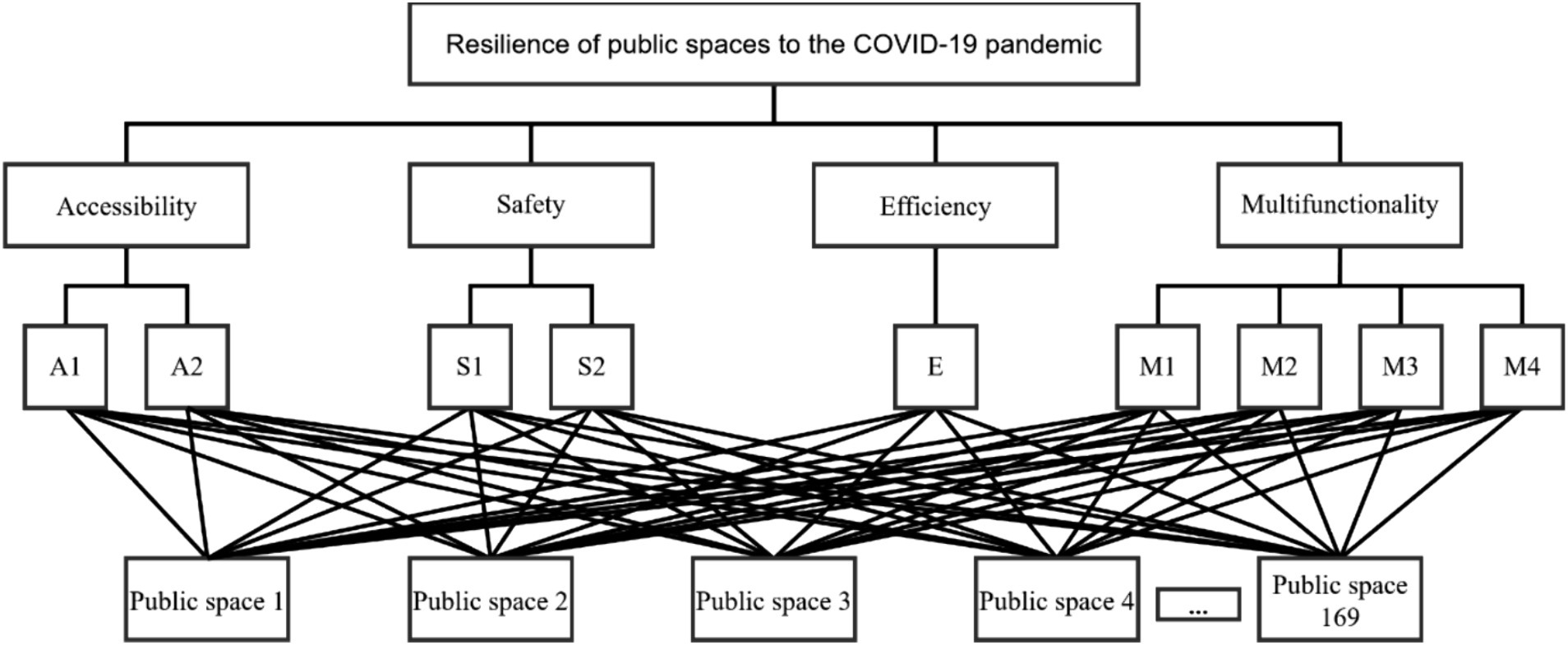
Figure 2. Hierarchy of COVID-19 pandemic-resilient public spaces decision process (see Table 6 for the codes meaning).
Second, the importance scale was determined. This phase is carried out by analyzing the findings of the expert assessment of the pandemic resilience criteria and recategorizing them into numerical expressions of AHP on a scale of 1 to 9 (Table 3).
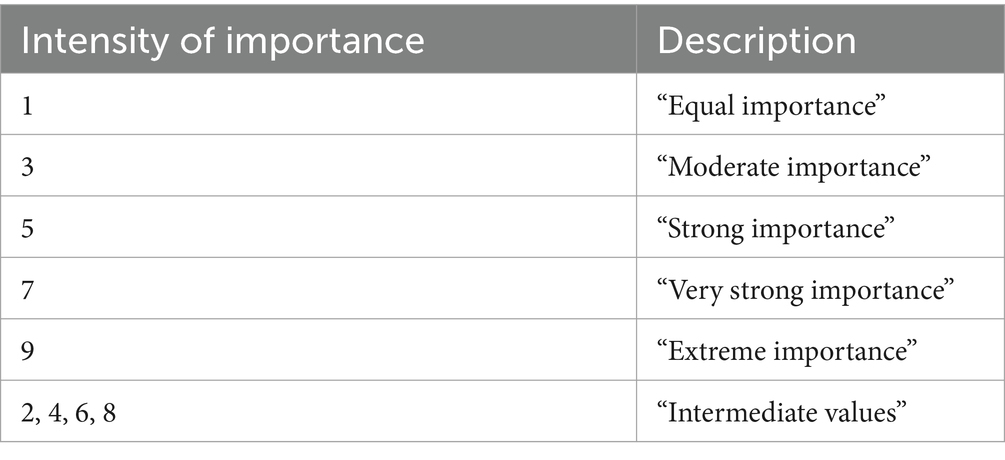
Table 3. 1–9 fundamental scale (Saaty, 2008).
Third, the pairwise comparison matrix was constructed according to the importance scale value. Each pair of sub-criteria is compared following its importance (Table 4).
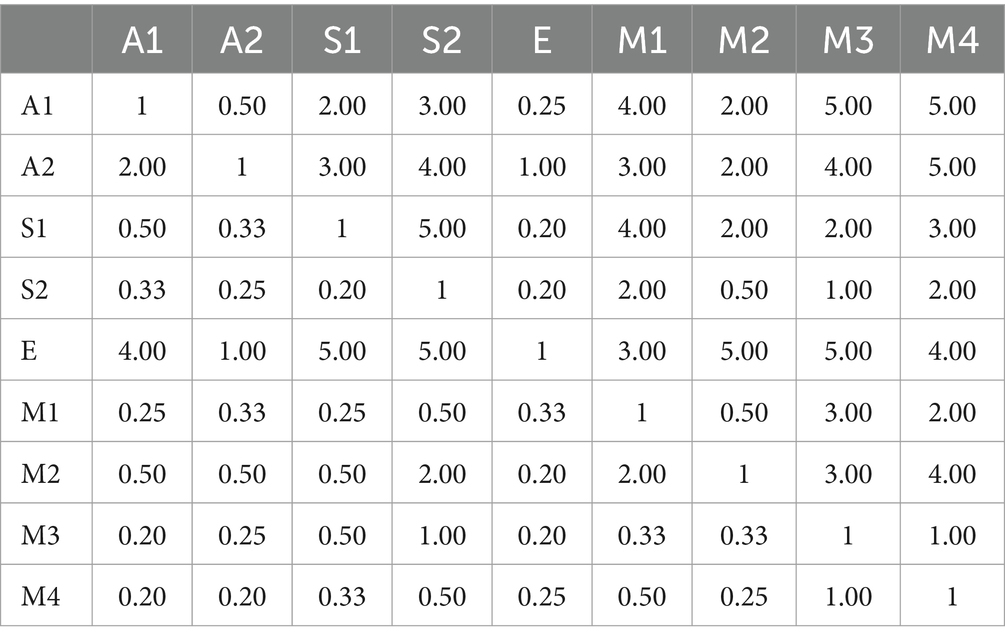
Table 4. Pairwise comparison matrix of the AHP method (see Table 6 for the code meaning).
Fourth, the consistency of the matrix was confirmed.
(Table 5).

Table 5. Random consistency index (RI) (Thanki et al., 2016).
CR = 0.13030886 / 1.45 = 0. 09248 < 0.10 [consistency ratio as decided by Saaty (Saaty, 2008)]. All weights are reasonable and shown in Table 6.
The study also utilized the WOA method, a prominent approach in GIS-based research for resilience assessment. This method offers a flexible framework that integrates both qualitative and quantitative factors (Mabahwi et al., 2021). WOA entails overlaying maps with various criteria and applying respective weights to generate a final assessment, pinpointing optimal solutions. Many recent studies utilized WOA in multi-criteria analysis and investigations related to disaster preparedness (Şentürk and Erener, 2017; Junian and Azizifar, 2018; Hoque et al., 2019; Zabihi et al., 2019; Alawi et al., 2023).
In this study, WOA was applied to gage the pandemic resilience level, identifying public spaces most resilient to the pandemic. Initially, all GIS data concerning pandemic resilience criteria were transformed into raster format. Subsequently, they underwent reclassification and superposition using the function of weighted overlay. The factors’ weights were determined based on the pairwise comparison matrix outlined above.
4 Results and discussion
4.1 Evaluating the impact of the COVID-19 pandemic on the existing public spaces in Chongqing
4.1.1 The impact on public spaces during severe phases of the pandemic
Like other components of the city of Chongqing and the entire country of China, public spaces were completely closed during the severe waves of the pandemic. During those challenging periods, public spaces, which were once vibrant centers of social interaction, transformed into dormant areas (Figure 3A). The complete closure of public spaces has had profound effects on Chongqing residents. The inability to access public spaces has deprived people of their customary outlets for exercise, relaxation, and social interaction, resulting in increased feelings of social isolation and physical and mental health problems.
4.1.2 The impact on public spaces during moderate phases of the pandemic
Despite the great significance that studies confirm on the public spaces’ role amid the COVID-19 pandemic (Husky et al., 2020; Wang et al., 2020; Samuelsson et al., 2020a; Soga et al., 2021; Yao et al., 2022). This study’s results show that the public spaces in Chongqing are not prepared to give effective responsiveness to the pandemic (Figure 3). The results (Table 7) show a decrease in the number of visits to public spaces amid the COVID-19 pandemic compared to the period before the pandemic in all three studied regions. The findings indicate that the University town experienced the smallest reduction in the number of visits, with a mean of 0.327, followed by the old Shapingba area with a mean of 0.430, while the Yuzhong region witnessed the highest decrease at 0.489. Similarly, the time users spent in public spaces decreased during the pandemic period in all three regions, as illustrated in Table 8. University town had the lowest decrease in time spent in public spaces during the pandemic, with a mean of 0.086, followed by the old Shapingba area with a mean of 0.192, while the Yuzhong region experienced the highest decrease at 0.416. Table 9 reveals changes in activities performed in public spaces between the pre-pandemic and pandemic periods. Across all studied regions, activities decreased during the pandemic compared to the pre-pandemic period. University town exhibited the smallest decrease in activities, with a mean of 0.03023, followed by the old Shapingba area with a mean of 0.03756, while the Yuzhong region had the highest decrease with a mean of 0.06393. These findings agree with the studies of (Nelson Grima et al., 2020; Xie et al., 2020; Addas and Maghrabi, 2022) on the decrease in the use of public spaces after easing the pandemic restrictions and allowing people to use public spaces while respecting the pandemic measures.
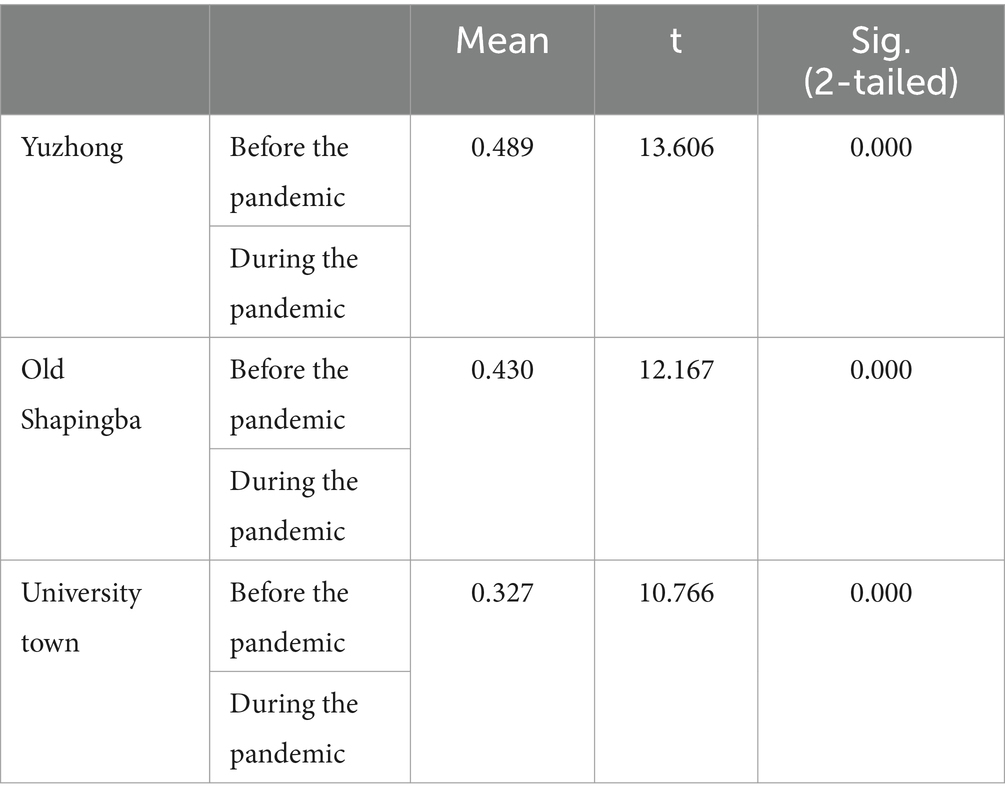
Table 7. The weekly visits to public spaces before and during the pandemic (a higher mean indicates a greater increase in weekly visits).

Table 8. The difference in the time spent in public spaces during the visits before and during the pandemic (a higher mean indicates a greater increase in the time spent in public spaces).
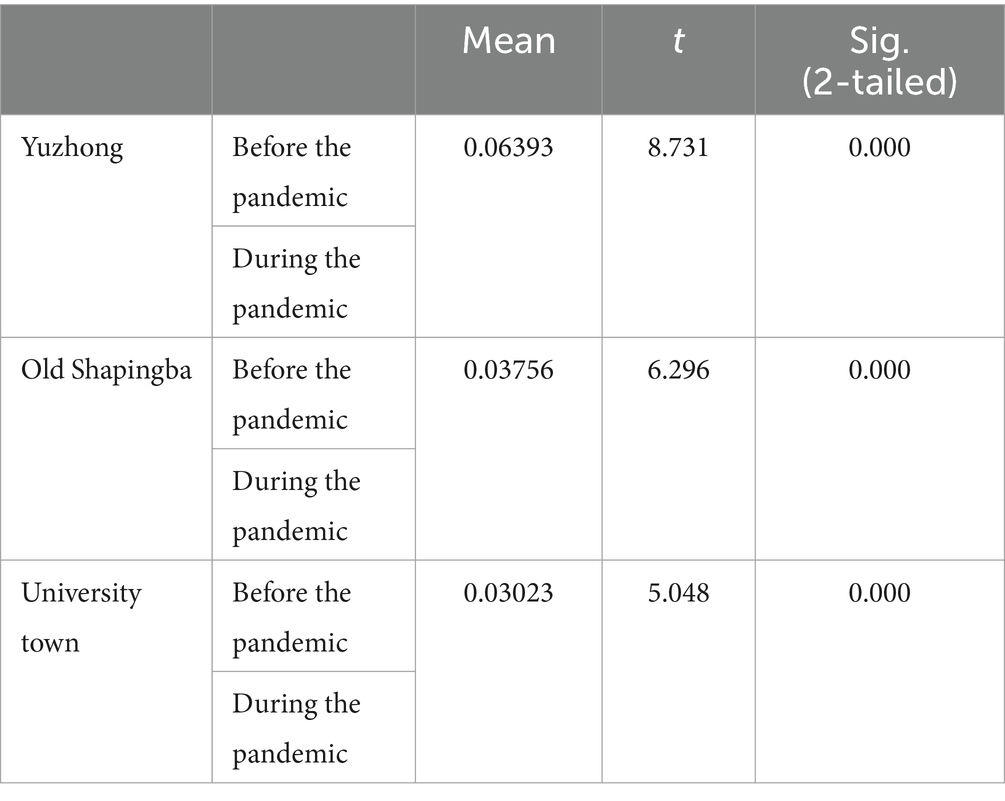
Table 9. The difference in activities in public spaces before and during the pandemic (a higher mean indicates a greater increase in activities performed in public spaces).
4.1.3 The impact on public spaces after the complete reopening of China and the cessation of the pandemic restrictions
The results indicate that the complete reopening process marked a significant turning point in revitalizing public spaces (Figure 3C). People returned to visit public spaces more frequently compared to the pandemic period. The analysis results (Table 10) demonstrate an increase in the number of visits across all three studied regions. The findings indicate that the Yuzhong region experienced the highest increase in the number of visits, with a mean of 0.452, followed by the University town with a mean of 0.417, while the old Shapingba area witnessed the lowest increase, with a mean of 0.413. Similarly, the time users spent in public spaces increased after the pandemic compared to the pandemic period, as illustrated in Table 11. The Yuzhong region had the highest increase in time spent in public spaces during the pandemic, with a mean of 0.453, followed by the old Shapingba area with a mean of 0.237, while the University town experienced the lowest increase, with a mean of 0.128. Table 12 reveals changes in activities performed in public spaces between the pandemic and post-pandemic periods. Across all studied regions, activities increased in the post-pandemic period compared to the preceding pandemic period. The Yuzhong region exhibited the highest increase in activities, with a mean of 0.073, followed by the old Shapingba area with a mean of 0.045, while the University town had the lowest increase, with a mean of 0.035.
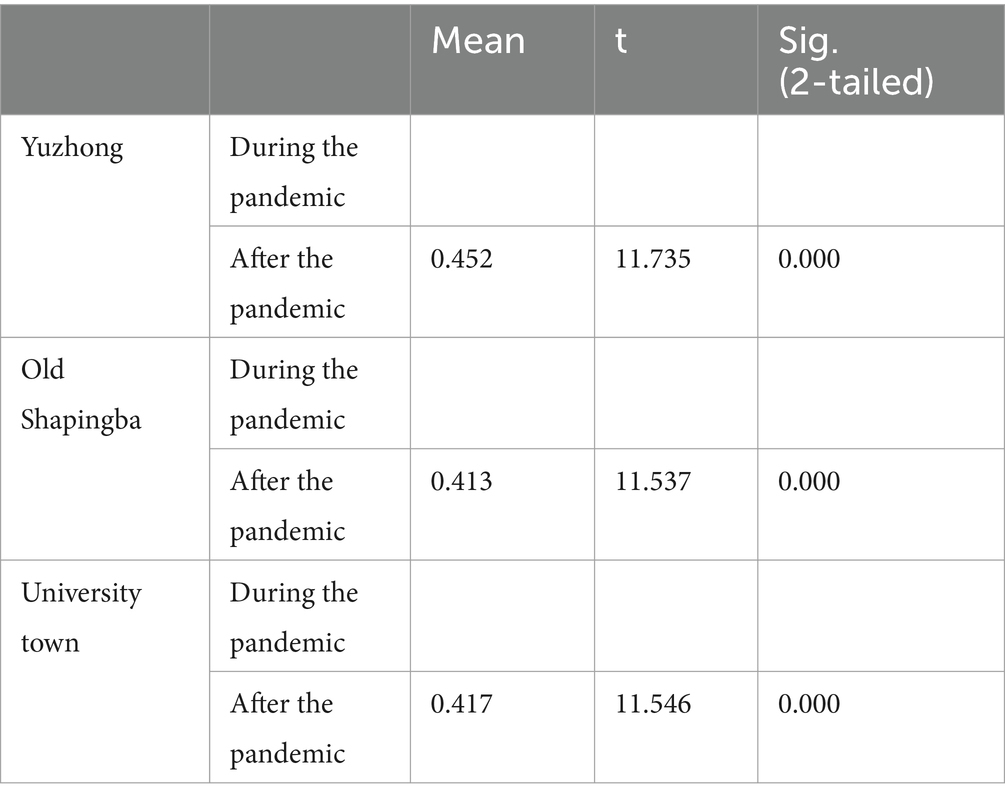
Table 10. The weekly visits to public spaces during and after the pandemic (a higher mean indicates a greater increase in weekly visits).
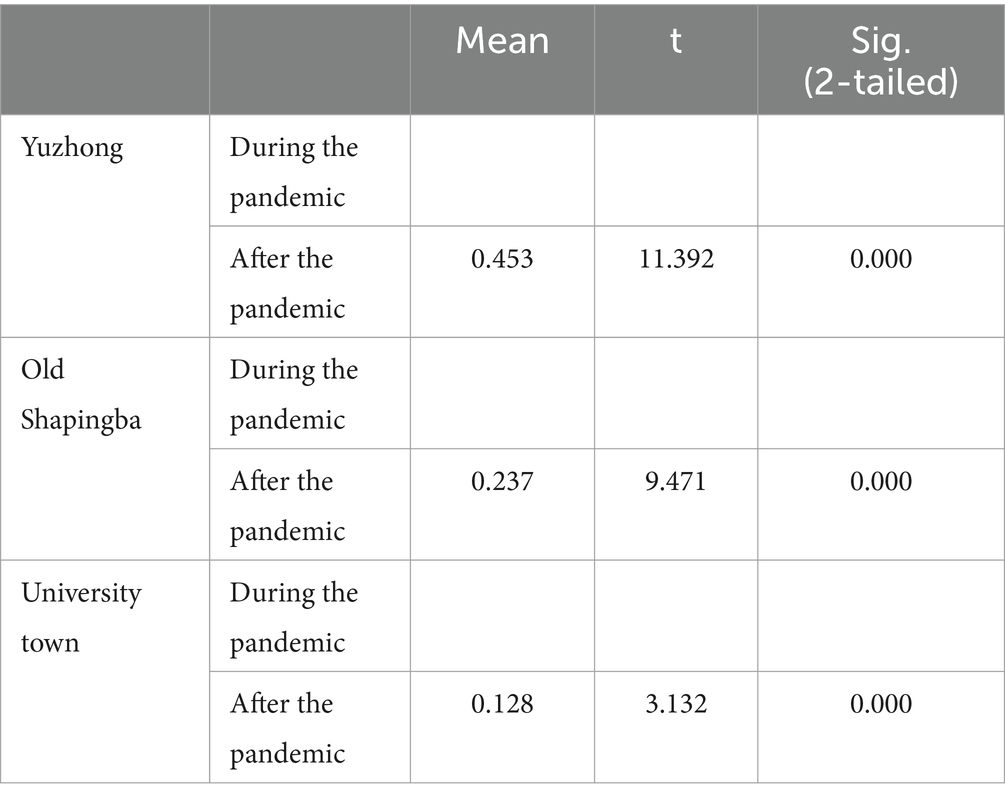
Table 11. The difference in the time spent in public spaces during the visits during and after the pandemic (a higher mean indicates a greater increase in the time spent in public spaces).
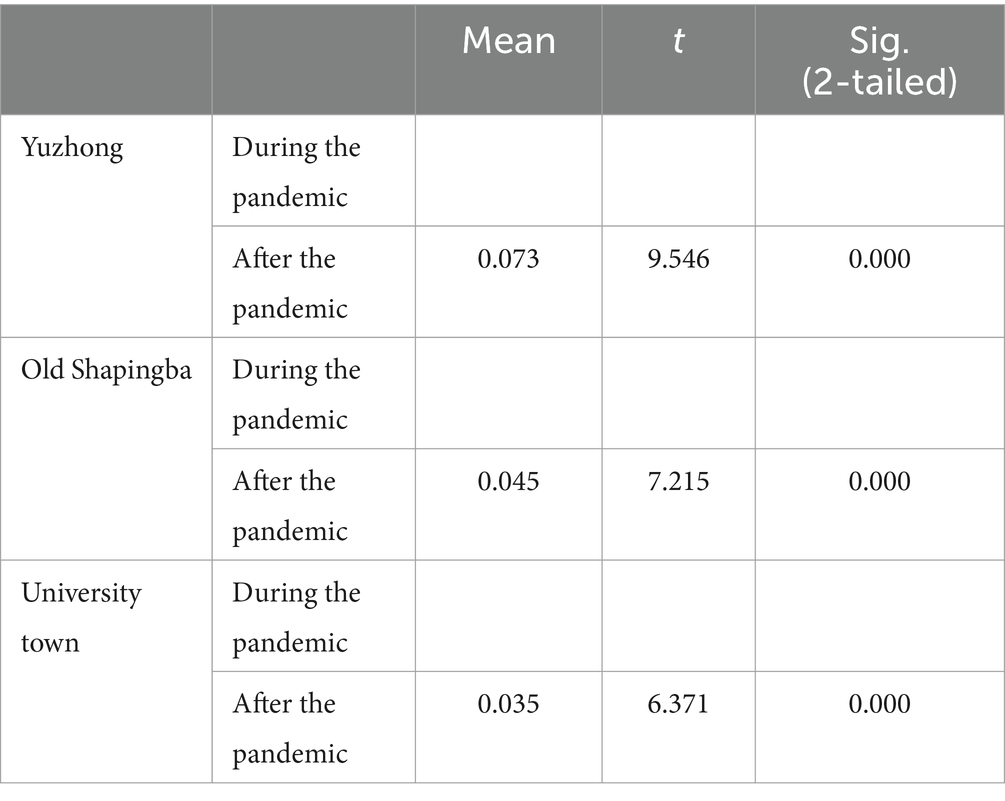
Table 12. The difference in activities in public spaces during and after the pandemic (a higher mean indicates a greater increase in activities performed in public spaces).
These results affirm that public spaces experienced a decline in their vibrancy during the pandemic (Table 13) despite the easing of restrictions and the ability of people to use public spaces while adhering to pandemic measures like wearing masks, temperature checks, and practicing social distancing. Resulting in not fully benefiting from the advantages of public spaces during the pandemic. This situation necessitates a reassessment of public spaces to identify their weaknesses and facilitate their development, ensuring they can continue to perform all their functions effectively in case of future COVID-19 pandemic waves or the emergence of new respiratory diseases. These aspects will be further addressed in the following part.
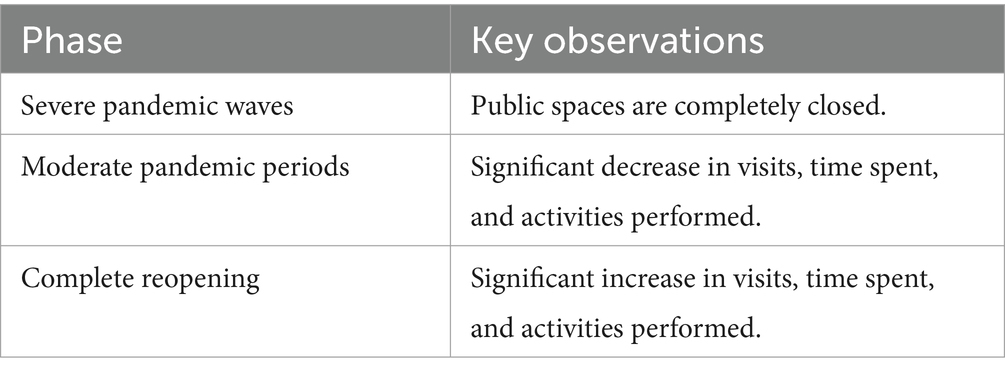
Table 13. Summary of the impact of the COVID-19 pandemic on the existing public spaces in Chongqing.
4.2 Assessing the COVID-19 pandemic resilience criteria in public spaces
The findings in the previous part clarified that public spaces in Chongqing are not adequately prepared to deal with pandemics. The results in this section explain the reasons behind the reduced utilization of public spaces during the pandemic, elucidating the criteria for pandemic resilience in public spaces as outlined in part 3.3. This part aims to assess the current state of public spaces, identify weaknesses, and strive for improvement to prevent restrictions on public space usage in the event of future pandemics.
4.2.1 Accessibility
Accessibility was measured by two sub-criteria: active transportation network and the proximity of public spaces to homes. The study results indicate an inequity in the accessibility to public spaces in the studied areas, which requires rethinking on fairly creating public spaces that allow all residents to reach the public spaces safely and efficiently and do the activities they need as close to their homes as possible, thus contributing in reducing the risk of infection during pandemics, especially in the high-density areas such as Chongqing.
The results (Figure 4B) show that the public spaces’ proximity to homes varies from neutral to suitable levels in all studied areas. However, the proximity of public spaces to homes is affected by the nature of active transportation networks connected to them. In this regard, the findings (Figure 4A) reveal that the University town, characterized by its flat geographical nature and modern establishment, boasts acceptable levels of active transportation networks. Meanwhile, the Yuzhong and old Shapingba regions, with a mountainous nature and higher population density, especially the Yuzhong region area, face deficiencies in the active transportation network connecting public spaces with homes (Figure 5A). This poses substantial challenges during pandemics. The inadequacy of a proper active transportation network could elevate the risk of infection when using that infrastructure during pandemic times (World Health Organization, 2022). Furthermore, individuals may be compelled to use public transportation, thereby heightening the risk of infection.
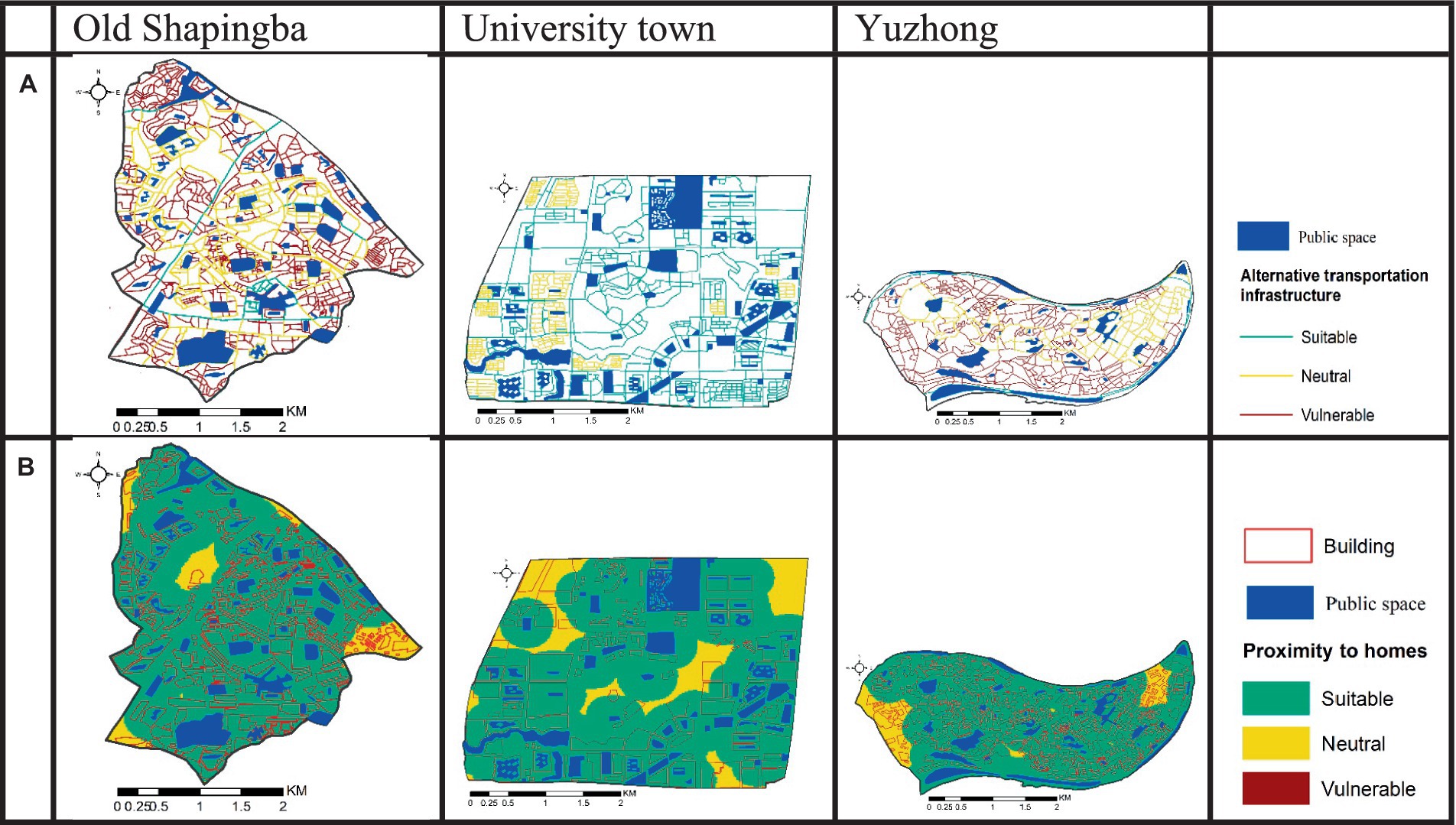
Figure 4. Pandemic accessibility criteria: (A) active transportation network; (B) proximity of public spaces to homes.
4.2.2 Safety
Safety was studied through two sub-criteria: the presence of social distancing techniques and the availability of monitoring and access control. The findings clarify that the absence of social distancing techniques poses a significant safety risk when using public spaces during the pandemic in all the studied areas. The results (Figure 6A) show that most public spaces in all the studied regions have vulnerable levels in terms of the availability of social distancing techniques, which constitutes a major obstacle to using these spaces during the pandemic (Arafat et al., 2021), particularly in highly populated regions such as Chongqing (Figure 5B). Regarding the availability of monitoring and access control points, the results (Figure 6B) show that the resilience level of monitoring and access control of public spaces ranges between neutral and suitable levels. In terms of monitoring, Chongqing is distinguished by good monitoring levels throughout the municipality, including public spaces (Figure 5C). In terms of access control, some types of public spaces, such as waterfronts and squares, lack access control, which leads to ignoring checking the wearing of masks and measuring the body temperature of visitors before they enter public spaces during the pandemic, which then leads to increased risks of infection (Arafat et al., 2021).
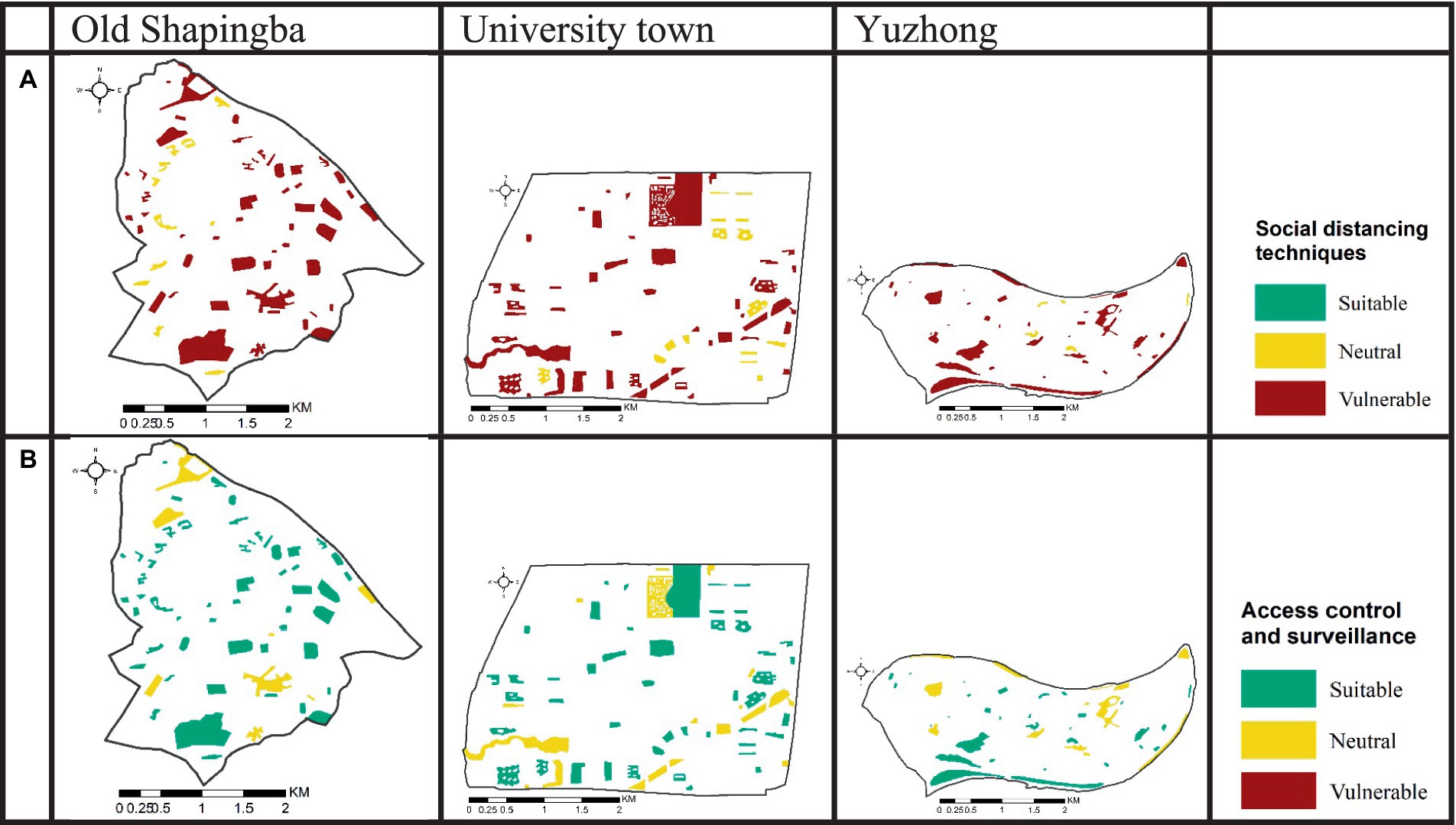
Figure 6. Pandemic safety criteria: (A) social distancing techniques; (B) monitoring and access control.
4.2.3 Efficiency
Efficiency was examined by calculating the usable size of public spaces and determining their capacity for use during the pandemic while respecting the pandemic measures. The results in Figure 7 reveal that a limited number of public spaces meet the requirements for accommodating a large user base during the pandemic while maintaining social distancing. The majority of public spaces exhibit neutral levels, ensuring safe use for a moderate number of individuals during the pandemic. Some public spaces are categorized as vulnerable, presenting difficulties in enforcing social distancing measures during the pandemic.
Table 14 shows different efficiency levels of public spaces between the studied regions. The University town region has the most efficient public spaces, followed by the region of old Shapingba. Whereas the Yuzhong region has the least efficient public spaces. The public spaces in the University town region can serve around one and a half times the total region’s population, which accounts for 186,449 people (Statistics SDBO, 2021) while maintaining social distancing to protect users against infection. In the old Shapingba region of 213,134 people (Statistics SDBO, 2021), the public spaces can almost serve the entire number of the region’s residents at the same time. While in the Yuzhong region, the public spaces can serve only roughly a third of the region’s population, which numbers 377,613 people (Statistics YDBO, 2021).
Despite the acceptable total usable size of public spaces, especially in the regions of the University town and old Shapingba, the absence of fair distribution of public spaces between the various parts within the region as well as the absence of justice in the distribution of attraction features. This include the absence of justice in the availability of accessibility, safety, and multifunctionality factors between the different public spaces, which bring major challenges for using public spaces, especially during the pandemic. On the one hand, these issues lead to a lack of public spaces that meet the users’ needs within a short distance from homes in some areas, thus a reduction in using public spaces, which has a negative effect on people’s health, especially during the pandemic. On the other hand, these issues may result in overcrowding in specific public spaces in some areas, which increases the risk of infection during the pandemic (Figure 5D).
4.2.4 Multifunctionality
Multifunctionality was studied through four sub-criteria that attract users for daily visits and make the spaces meet and adapt to the pandemic requirements: link to nature, spaces for physical activities, smart furniture, and public services. The results (Figure 8) show different levels of the presence of the multifunctionality factors.
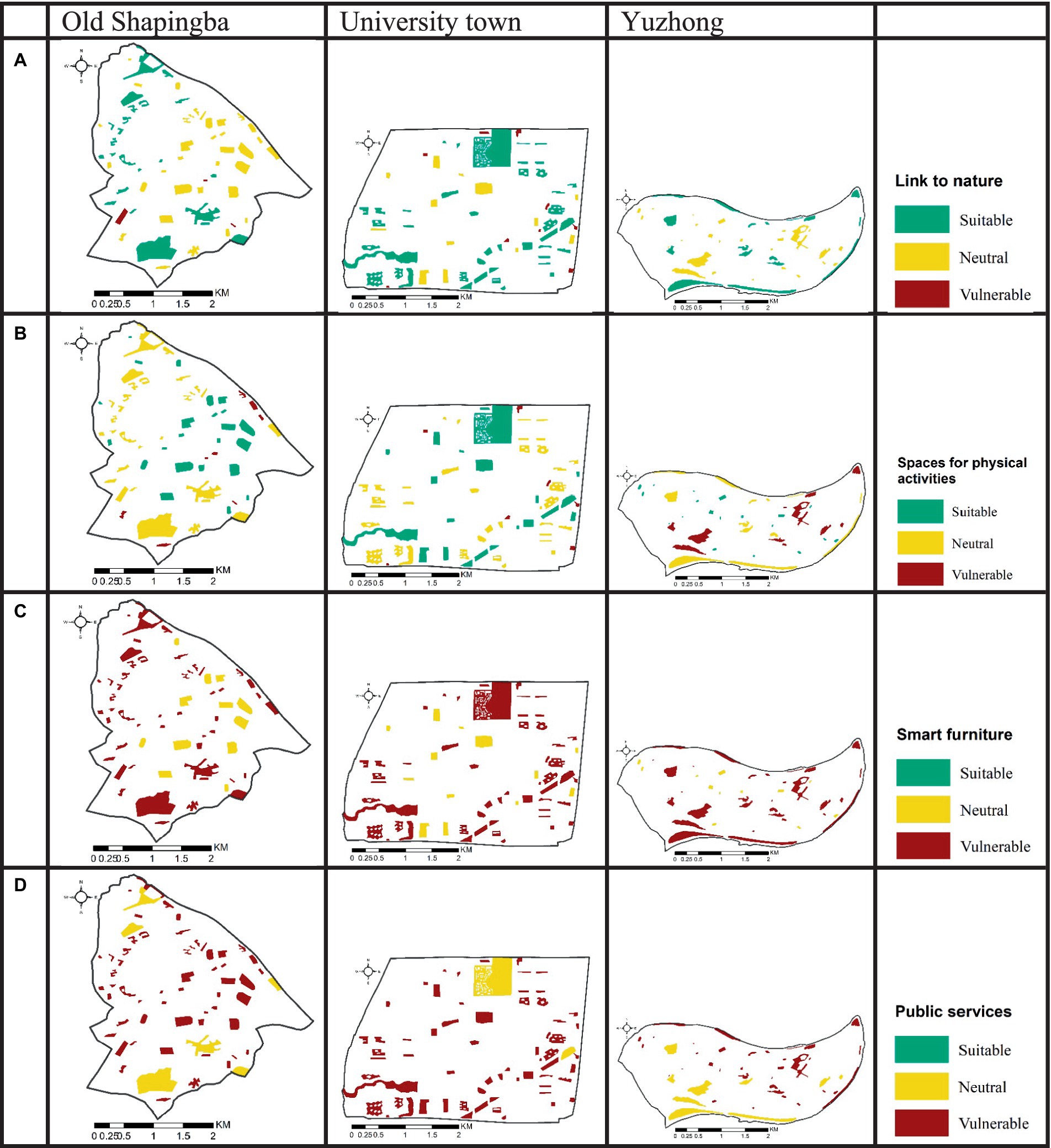
Figure 8. Pandemic multifunctionality criteria: (A) link to nature; (B) spaces for physical activities; (C) smart furniture; (D) public services.
The results indicate that the least available factors are smart furniture and public services (Figures 8C,D), which affect the use of public spaces amid the pandemic. The lack of smart furniture restricts the potential for diverse uses and the implementation of extra solutions during the pandemic (Shaleh et al., 2022). On the other hand, the availability of public services, such as touch-free hand washing, sterile public services, and space quality, play a vital role in upholding personal hygiene and preventing manual contact with equipment to curb the transmission of infections among users (Chawla, 2021).
In terms of the availability of spaces for physical activities (Figure 8B), the old Shapingba and University town regions exhibit satisfactory levels of free spaces within their public areas. While the Yuzhong region faces a shortage of free spaces in numerous public spaces, diminishing their suitability for the physical activities essential for users during the pandemic (McDougall et al., 2021). Regarding the link to nature (Figure 8A), most public spaces in all the studied areas have levels ranging from neutral to suitable.
The differences in levels of multifunctionality factors lead to users’ preferences for public spaces that include high levels of multifunctionality aspects, including links to nature, spaces for physical activities, smart furniture, and public services. This results in overcrowding in some spaces and underutilization of others (see Figure 5E). This imbalance significantly impacts the response to the pandemic, amplifying the effects incurred from this emergency.
4.3 Determining the pandemic resilience level of public spaces
The results in Figure 9 indicate different levels of pandemic resilience in public spaces between the studied regions. These resilience levels are influenced by the characteristics of each region. The University town region, with its newly established public spaces, flat geographic nature, and the lowest population density compared to the other studied regions (see part 3.1), achieved the most resilient public spaces compared to the other studied regions. The preference for resilience in the public spaces of the University town resulted in a better response to the pandemic. The results in part 4.1 show that the University town experienced the slightest mean difference in the reduction of the utilization of public spaces during the pandemic compared to the periods before and after the pandemic, including the number of visits, time spent in public spaces, and the activities performed in public spaces. In contrast, the Yuzhong area, with the highest population density and the most deeply sloped region, achieved the lowest level of resilience, resulting in the highest difference in the reduction of the utilization of public spaces during the pandemic compared to the periods before and after the pandemic.
However, the current resilience levels in public spaces of all the studied areas are insufficient to deal efficiently with the pandemic, as the results confirmed the decline in public spaces’ usage amid the pandemic in all the studied regions, including the University town (see part 4.1). In this regard, the pandemic resilience in public spaces in Chongqing requires a comprehensive, city-wide strategy. Targeted interventions should emphasize improving accessibility, enforcing robust safety protocols, optimizing efficiency, and fostering multifunctionality based on the criteria and norms presented in Table 2. These initiatives collectively contribute to establishing more resilient public spaces that can withstand and adeptly respond to the complexities of forthcoming health crises. The following part provides important suggestions for improving pandemic resilience in Chongqing’s public spaces.
4.4 Solutions and recommendations for improving the pandemic resilience in Chongqing public spaces
In light of the COVID-19 pandemic and its profound impact on cities, there is a pressing need for urban planners, architects, and policymakers to reevaluate current approaches to city planning and design. Historically, cities have not been specifically designed to be resilient to pandemics, as such events were rare occurrences. However, the experience of the COVID-19 pandemic underscores the critical importance of integrating pandemic resilience into urban planning and design practices. An urgent need arises to give more thought to creating resilient cities that can withstand the effects of a pandemic and to conduct further studies on how to measure the resilience of urban areas to disease outbreaks, improve governance, and incorporate physical design and planning into the built environment. In this context, resilience to outbreaks is high in cities with suitable, accessible, and utilizable public spaces for everyone. Therefore, cities should reinforce public spaces’ resilience and revise municipal financial and legislative tools to build resilient cities.
This study stresses the necessity for urban planners, architects, and policymakers to place a new focus alongside the existing focus on creating public spaces, which is on economic growth, scenic beauty, livability, and the vitality of cities. Focusing on pandemic resilience is essential. The public spaces need to be established to perform effectively in normal times and during pandemic emergencies by integrating the present focus aspects with the pandemic resilience aspects (Figure 10).
Based on the analysis results of each area, Table 15. Summarize the main interventions for improving the pandemic resilience in the public spaces of the studied regions. In addition, it’s important to engage the local community in the planning process. It allows for a better understanding of their needs and preferences, which can then be used to customize public spaces accordingly. Such community involvement fosters a sense of ownership and promotes responsible usage, especially during pandemics. Moreover, given Chongqing city’s continual changes and fast urbanization, it is recommended to re-assess public spaces every 5 years.
5 Conclusion
This study aims to improve public spaces’ resilience to the pandemic through two steps. First, it examines the response of present public spaces to the COVID-19 pandemic by comparing the daily use of public spaces before, during, and after the pandemic in three different regions in Chongqing, including Yuzhong, old Shapingba, and University town. Second, it investigates the pandemic resilience level in the public spaces of the studied regions through four main pandemic resilience criteria involving 9 sub-criteria that assure the effective responsiveness of public spaces to the pandemic: (1) accessibility, which involves active transportation network and proximity of public spaces to homes; (2) safety, which includes the presence of social distancing techniques and monitoring and access control; (3) efficiency, which is determined by analyzing the usable size of public spaces and calculating their capacity; and (4) multifunctionality, which involves the link to nature, spaces for physical activities, smart furniture, and public services.
The findings reveal a decrease in public space utilization during the COVID-19 pandemic compared to periods before and after the pandemic’s complete reopening. The study results indicate a decline in the number of visits, duration of stay, and range of activities conducted within public spaces across all three regions during the pandemic. The University town experienced the smallest reduction in public space utilization during the pandemic compared to the periods before and after the pandemic. Conversely, the Yuzhong area witnessed the highest reduction in public space utilization during the pandemic compared to the periods before and after. Moreover, the study results indicate that the pandemic resilience of public spaces in these regions is insufficient. However, the findings highlight that the University town region, which is characterized by lower population density and flat terrain and exhibited the least reduction in public space utilization during the pandemic, exhibits more resilient public spaces compared to the other regions, particularly the Yuzhong region, which is characterized by the highest population density and complex geographic terrain and the highest reduction of the utilization of public spaces during the pandemic.
This study makes an effective contribution to the fields of urban planning and design by outlining crucial criteria and suggestions for developing public spaces that guarantee an effective response to the pandemic. Furthermore, the methodology used in this study is an efficient approach for exploring and measuring the resilience level of public spaces. It helps decision-makers and planners explore the vulnerability of the present public spaces and develop solutions for improving their resilience.
6 Limitations and recommendations for future research
This work is a significant source for improving pandemic emergency preparedness in cities and ensuring an effective response from public spaces in the event of future pandemics and avoiding closure and restriction of their use. However, some limitations persist in the study. The results are limited to the public spaces of the studied regions in Chongqing. Nevertheless, the study methods, pandemic resilience criteria, and recommendations can be applied in other cities. Additionally, the study is focused only on the COVID-19 pandemic. Nonetheless, the study methods, resilience criteria, and recommendations can be applied to other pandemics, especially respiratory pandemics.
The study connected the difference in resilience levels results to the population density and the region’s physical characteristics; it did not address the economy and income levels of the residents of those regions, where other studies confirm their connection to the condition of the public spaces in the region (Nesbitt et al., 2019; Park and Guldmann, 2020). We recommend investigating these aspects in future research.
Future studies also need to concentrate on implementing the methodology in wider areas of Chongqing municipality to raise the pandemic resilience in the public spaces of the whole municipality. The study suggests extending the investigation on public spaces’ resilience to the pandemic in various cities to grow the expertise of planning and design pandemic-resilient public spaces in cities with their various characteristics.
Data availability statement
The original contributions presented in the study are included in the article/supplementary material, further inquiries can be directed to the corresponding author.
Ethics statement
Ethical review and approval was not required for the study on human participants in accordance with the local legislation and institutional requirements. Written informed consent from the [patients/participants OR patients/participants legal guardian/next of kin] was not required to participate in this study in accordance with the national legislation and the institutional requirements.
Author contributions
MA: Conceptualization, Formal analysis, Methodology, Software, Visualization, Writing – original draft, Writing – review & editing. DC: Conceptualization, Methodology, Supervision, Writing – review & editing. YR: Methodology, Writing – review & editing.
Funding
The author(s) declare that financial support was received for the research, authorship, and/or publication of this article. This research was funded by National Natural Science Foundation of China, grant number 52078070.
Conflict of interest
The authors declare that the research was conducted in the absence of any commercial or financial relationships that could be construed as a potential conflict of interest.
Publisher’s note
All claims expressed in this article are solely those of the authors and do not necessarily represent those of their affiliated organizations, or those of the publisher, the editors and the reviewers. Any product that may be evaluated in this article, or claim that may be made by its manufacturer, is not guaranteed or endorsed by the publisher.
References
Abdel-Razek, S. A., and Moanis, Y. (2021). Resilient urban open public spaces in during the Covid-19 pandemic. Int. Res. Innov. Forum 2021, 253–268. doi: 10.1007/978-3-030-84311-3_23
Addas, A., and Maghrabi, A. (2022). How did the COVID-19 pandemic impact urban green spaces? A multi-scale assessment of Jeddah megacity (Saudi Arabia). Urban For. Urban Green. 69:127493. doi: 10.1016/j.ufug.2022.127493
Aghababaei, M. T. S., Costello, S. B., and Ranjitkar, P. (2021). Measures to evaluate post-disaster trip resilience on road networks. J. Transp. Geogr. 95:103154. doi: 10.1016/j.jtrangeo.2021.103154
Ahmadpoor, N., and Shahab, S. (2021). Realising the value of greenspace: A planners' perspective on the COVID-19 pandemic. Town Plan. Rev. 92, 49–55. doi: 10.3828/tpr.2020.37
Alawi, M., Chu, D., and Hammad, S. (2023). Resilience of public open spaces to earthquakes: A case study of Chongqing, China. Sustainability 15:1092. doi: 10.3390/su15021092
Alawneh, S. M., and Rashid, M. (2022). Revisiting urban resilience: A review on resilience of spatial structure in urban refugee neighborhoods facing demographic changes. Front. Sustain. Cities 4:806531. doi: 10.3389/frsc.2022.806531
Alkhaja, N., Alawadi, K., and Ibrahim, H. M. (2023). Post-pandemic planning: do we have enough and efficient access to parks? Front. Built Environ. 9:1158430. doi: 10.3389/fbuil.2023.1158430
Arafat, P., Silvalia, M., and Sari, S. (2021). Open space preference and adaption in creating safe environment in Banda Aceh, Indonesia. IOP Conf. Ser. Earth Environ. Sci. 881:012069. doi: 10.1088/1755-1315/881/1/012069
Bakir, R. A., and Attia, S. A. (2021). Changing use of public spaces in Cairo during COVID-19. Urban Res. Pract. 14, 576–593. doi: 10.1080/17535069.2021.2006897
Bayramoğlu, E., Kurdoğlu, B. Ç., and Seyhan, S. (2021). Social distance applications in urban green areas in pandemic. In: 4th International Conference of Contemporary Affairs in Architecture and Urbanism (ICCAUA-2021). (Turkey). doi: 10.38027/ICCAUA2021222N14
Burrowes, K., and Schilling, J. (2021). From the streets to citizen spaces: Positioning parks and green spaces in an equitable COVID-19 recovery.
Canada PHAO . (2020). Coronavirus disease (COVID-19): Prevention and risks. Ottawa, ON: PHAC. Available at: http://www.canada.ca/en/public-health/services/diseases/2019-novel-coronavirus-infection/prevention-risks.html (Accessed March 28, 2022).
Cetin, M. (2015). Using GIS analysis to assess urban green space in terms of accessibility: case study in Kutahya. Int J Sust Dev World 22, 1–5. doi: 10.1080/13504509.2015.1061066
Chawla, N. A. (2021). How public spaces can adapt to a post- pandemic world. The Daily Guardian. Available at: https://thedailyguardian.com/how-public-spaces-can-adapt-to-a-post-pandemic-world/ (Accessed April 5, 2022).
China MOHA . (2018). Standard for urban planning on comprehensive disaster resistance and prevention (GB/T 51327–2018). Available at: https://www.mohurd.gov.cn/gongkai/fdzdgknr/tzgg/201903/20190320_239841.html (Accessed April 27, 2022).
Covatta, A., and Ikalović, V. (2022). Urban resilience: A study of leftover spaces and play in Dense City fabric. Sustain. For. 14:13514. doi: 10.3390/su142013514
Da Schio, N., Phillips, A., Fransen, K., Wolff, M., Haase, D., Ostoić, S. K., et al. (2021). The impact of the COVID-19 pandemic on the use of and attitudes towards urban forests and green spaces: exploring the instigators of change in Belgium. Urban For. Urban Green. 65:127305. doi: 10.1016/j.ufug.2021.127305
Das, M., Das, A., Giri, B., Sarkar, R., and Saha, S. (2021). Habitat vulnerability in slum areas of India–what we learnt from COVID-19? Int. J. Disaster Risk Reduct. 65:102553. doi: 10.1016/j.ijdrr.2021.102553
De Brito, M. M., and Evers, M. (2016). Multi-criteria decision-making for flood risk management: a survey of the current state of the art. Nat. Hazards Earth Syst. Sci. 16, 1019–1033. doi: 10.5194/nhess-16-1019-2016
Ding, D., and Zhang, R. (2022). China's COVID-19 control strategy and its impact on the global pandemic. Front. Public Health 10:857003. doi: 10.3389/fpubh.2022.857003
Eltarabily, S., and Elghezanwy, D. (2020). Post-pandemic cities-the impact of COVID-19 on cities and urban design. Arch. Res. 10, 75–84. doi: 10.5923/j.arch.20201003.02
England, N. (2020). Natural England, 2020. The People and Nature Survey for England: Adult Data Y1Q1 (April–June 2020) (Experimental Statistics) Official Statistics. Available at: https://www.gov.uk/government/publications/the-people-and-nature-survey-for-england-adult-data-y1q1-april-june-2020-experimental-statistics/the-people-and-nature-survey-for-england-adult-data-y1q1-april-june-2020-experimental-statistics (Accessed May 5, 2021).
Erdönmez, C., and Atmiş, E. (2021). The impact of the Covid-19 pandemic on green space use in Turkey: is closing green spaces for use a solution? Urban For. Urban Green. 64:127295. doi: 10.1016/j.ufug.2021.127295
Gallerani, D. G., Besenyi, G. M., Stanis, S. A. W., and Kaczynski, A. T. (2017). “We actually care and we want to make the parks better”: A qualitative study of youth experiences and perceptions after conducting park audits. Prev. Med. 95, S109–S114. doi: 10.1016/j.ypmed.2016.08.043
Garcia, C. (2020). City Square: redefining public spaces during and after the pandemic. ArchDaily. Available at: https://www.archdaily.com/952145/city-square-redefining-public-spaces-during-and-after-the-pandemic (Accessed July 12, 2022).
Geng, D. C., Innes, J., Wu, W., and Wang, G. (2021). Impacts of COVID-19 pandemic on urban park visitation: a global analysis. J. For. Res. 32, 553–567. doi: 10.1007/s11676-020-01249-w
Gutiérrez, F. (2023). ‘I will stay here’: public space and social inequality during the COVID-19 pandemic. J. Urban Des. 29, 263–279. doi: 10.1080/13574809.2023.2245336
Haase, A. (2020). Covid-19 as a social crisis and justice challenge for cities. Front. Sociol. 5:583638. doi: 10.3389/fsoc.2020.583638
Han, S., Bohannon, C. L., and Kwon, Y. (2021). How has the COVID-19 pandemic affected the perceptions of public space employees? Land 10:1332. doi: 10.3390/land10121332
Haq, S. M. A. (2011). Urban green spaces and an integrative approach to sustainable environment. J. Environ. Prot. 02, 601–608. doi: 10.4236/jep.2011.25069
Hassanzadeh-Rad, A., and Halabchi, F. (2020). Stadiums as possible hot spots for COVID-19 spread. Asian J. Sports Med. 11:e103178. doi: 10.5812/asjsm.103178
Hohl, A., and Lotfata, A. (2022). A geographical analysis of socioeconomic and environmental drivers of physical inactivity in post pandemic cities: the case study of Chicago, IL, USA. Urban Sci. 6:28. doi: 10.3390/urbansci6020028
Honey-Rosés, J., Anguelovski, I., Chireh, V. K., Daher, C., Konijnendijk van den Bosch, C., Litt, J. S., et al. (2021). The impact of COVID-19 on public space: an early review of the emerging questions–design, perceptions and inequities. Cities Health 5, S263–S279. doi: 10.1080/23748834.2020.1780074
Hoque, M. A.-A., Tasfia, S., Ahmed, N., and Pradhan, B. (2019). Assessing spatial flood vulnerability at Kalapara Upazila in Bangladesh using an analytic hierarchy process. Sensors 19:1302. doi: 10.3390/s19061302
Hossain, N. (2014). Street’as accessible open space network in earthquake recovery planning in unplanned urban areas. Asian J. Hum. Soc. Sci. 2, 103–115,
Huerta, C. M. (2022). Rethinking the distribution of urban green spaces in Mexico City: lessons from the COVID-19 outbreak. Urban For. Urban Green. 70:127525. doi: 10.1016/j.ufug.2022.127525
Husky, M. M., Kovess-Masfety, V., and Swendsen, J. D. (2020). Stress and anxiety among university students in France during Covid-19 mandatory confinement. Compr. Psychiatry 102:152191. doi: 10.1016/j.comppsych.2020.152191
Ibes, D. C. (2015). A multi-dimensional classification and equity analysis of an urban park system: A novel methodology and case study application. Landsc. Urban Plan. 137, 122–137. doi: 10.1016/j.landurbplan.2014.12.014
Jato-Espino, D., Moscardó, V., Rodríguez, A. V., and Lázaro, E. (2022). Spatial statistical analysis of the relationship between self-reported mental health during the COVID-19 lockdown and closeness to green infrastructure. Urban For. Urban Green. 68:127457. doi: 10.1016/j.ufug.2021.127457
Johnson, T. F., Hordley, L. A., Greenwell, M. P., and Evans, L. C. (2020). Effect of park use and landscape structure on COVID-19 transmission rates. MedRxiv 2020:20215731. doi: 10.1101/2020.10.20.20215731
Junian, J., and Azizifar, V. (2018). The evaluation of temporary shelter areas locations using geographic information system and analytic hierarchy process. Civil Eng. J. 4, 1678–1688. doi: 10.28991/cej-03091104
Kleinschroth, F., and Kowarik, I. (2020). COVID-19 crisis demonstrates the urgent need for urban greenspaces. Front. Ecol. Environ. 18, 318–319. doi: 10.1002/fee.2230
Kordshakeri, P., and Fazeli, E. (2020). How the COVID-19 pandemic highlights the lack of accessible public spaces in Tehran. Cities Health 5, S220–S222. doi: 10.1080/23748834.2020.1817690
Korpilo, S., Kajosaari, A., Rinne, T., Hasanzadeh, K., Raymond, C. M., and Kyttä, M. (2021). Coping with crisis: green space use in Helsinki before and during the COVID-19 pandemic. Front. Sustain. Cities 3:713977. doi: 10.3389/frsc.2021.713977
Lancet, T. (2020). COVID-19: learning from experience. Lancet 395:1011. doi: 10.1016/S0140-6736(20)30686-3
Le Texier, M., Schiel, K., and Caruso, G. (2018). The provision of urban green space and its accessibility: spatial data effects in Brussels. PLoS One 13:e0204684. doi: 10.1371/journal.pone.0204684
Liu, S., and Wang, X. (2021). Reexamine the value of urban pocket parks under the impact of the COVID-19. Urban For. Urban Green. 64:127294. doi: 10.1016/j.ufug.2021.127294
Logan, T. M., and Guikema, S. D. (2020). Reframing resilience: Equitable access to essential services. Risk Anal. 40, 1538–1553. doi: 10.1111/risa.13492
Lopez, B., Kennedy, C., Field, C., and McPhearson, T. (2021). Who benefits from urban green spaces during times of crisis? Perception and use of urban green spaces in new York City during the COVID-19 pandemic. Urban For. Urban Green. 65:127354. doi: 10.1016/j.ufug.2021.127354
Mabahwi, N. A. B., Bhattacharya, Y., and Nakamura, H. (2021). GIS-based multi-criteria analysis to identify site suitability of flood shelters in Kuantan, Malaysia. In: IOP Conference Series: Earth and Environmental Science: IOP Publishing, No. 012027.
Macioszek, E., and Granà, A. (2021). The analysis of the factors influencing the severity of bicyclist injury in bicyclist-vehicle crashes. Sustain. For. 14:215. doi: 10.3390/su14010215
Macioszek, E., Granà, A., and Krawiec, S. (2023). Identification of factors increasing the risk of pedestrian death in road accidents involving a pedestrian with a motor vehicle. Arch. Transport 65, 7–25. doi: 10.5604/01.3001.0016.2474
Mason, D., and Brabhaharan, P. (2021). Characterisation of transport resilience and measures to enhance resilience in the recovery after the 2016 Kaikōura earthquake. Bull. N. Z. Soc. Earthq. Eng. 54, 69–81. doi: 10.5459/bnzsee.54.2.69-81
McDougall, C. W., Brown, C., Thomson, C., Hanley, N., Tully, M. A., Quilliam, R. S., et al. (2021). From one pandemic to another: emerging lessons from COVID-19 for tackling physical inactivity in cities. Cities Health 5, S181–S184. doi: 10.1080/23748834.2020.1785165
Mehta, V. (2020). The new proxemics: COVID-19, social distancing, and sociable space. J. Urban Des. 25, 669–674. doi: 10.1080/13574809.2020.1785283
Mengistu, D. T., Gebremariam, E., Wang, X., and Zhao, S. (2022). Pandemic-resilient urban centers: A new way of thinking for industrial-oriented urbanization in Ethiopia. Urban Sci. 6:26. doi: 10.3390/urbansci6020026
Meter, W. (2024). COVID-19 coronavirus pandemic. Available at: https://www.worldometers.info/coronavirus (Accessed March 4, 2024).
Misiune, I. (2023). Do we need different urban green spaces now? A case study of preferences during pandemics. Land 12:2106. doi: 10.3390/land12122106
Nelson Grima, W. C., Corinne Hill-James, B. L., and Haley Sommer, B. F. (2020). The importance of urban natural areas and urban ecosystem services during the COVID-19 pandemic. PLoS One 15:e0243344. doi: 10.1371/journal.pone.0243344
Nesbitt, L., Meitner, M. J., Girling, C., Sheppard, S. R., and Lu, Y. (2019). Who has access to urban vegetation? A spatial analysis of distributional green equity in 10 US cities. Landsc. Urban Plan. 181, 51–79. doi: 10.1016/j.landurbplan.2018.08.007
Network, X. N. (2022). Chongqing: The total number of new infections in this round of epidemic has exceeded 80,000. Available at: http://www.cq.xinhuanet.com/2022-11/27/c_1129165263.htm (Accessed March 16, 2023).
Nicholls, S. (2001). Measuring the accessibility and equity of public parks: A case study using GIS. Manag. Leis. 6, 201–219. doi: 10.1080/13606710110084651
Nieuwenhuijsen, M. (2020). Urban and transport planning pathways to carbon neutral, liveable and healthy cities; A review of the current evidence. Environ. Int. 140:105661. doi: 10.1016/j.envint.2020.105661
Nobajas, A., Casas, J. G., Agustí, D. P., and Peacock, A. (2020). Lack of sufficient public space can limit the effectiveness of COVID-19’s social distancing measures. Medrxiv 2020:4982. doi: 10.1101/2020.06.07.20124982
Nu Nl . (2020). Lockdown Decision Has Been Made in the Netherlands: Here are All the Measures. Available at: https://www.nu.nl/uitleg-over-het-coronavirus/6096871/hollandada-kapanma-karar-alnd-iste-tum-onlemler.html (Accessed August 11, 2022).
Ortiz-Barrios, M., Borrego-Areyanes, A. A., Gómez-Villar, I. D., De Felice, F., Petrillo, A., Gul, M., et al. (2021). A multiple criteria decision-making approach for increasing the preparedness level of sales departments against COVID-19 and future pandemics: A real-world case. Int. J. Disaster Risk Reduct. 62:102411. doi: 10.1016/j.ijdrr.2021.102411
Palouj, M., Adaryani, R. L., Alambeigi, A., Movarej, M., and Sis, Y. S. (2021). Surveying the impact of the coronavirus (COVID-19) on the poultry supply chain: A mixed methods study. Food Control 126:108084. doi: 10.1016/j.foodcont.2021.108084
Pan, J., and Bardhan, R. (2022). Evaluating the risk of accessing green spaces in COVID-19 pandemic: A model for public urban green spaces (PUGS) in London. Urban For. Urban Green. 74:127648. doi: 10.1016/j.ufug.2022.127648
Pan, J., Bardhan, R., and Jin, Y. (2021). Spatial distributive effects of public green space and COVID-19 infection in London. Urban For. Urban Green. 62:127182. doi: 10.1016/j.ufug.2021.127182
Park, Y., and Guldmann, J.-M. (2020). Understanding disparities in community green accessibility under alternative green measures: A metropolitan-wide analysis of Columbus, Ohio, and Atlanta, Georgia. Landsc. Urban Plann. 200:103806. doi: 10.1016/j.landurbplan.2020.103806
Pipitone, J. M., and Jović, S. (2021). Urban green equity and COVID-19: effects on park use and sense of belonging in new York City. Urban For. Urban Green. 65:127338. doi: 10.1016/j.ufug.2021.127338
Poortinga, W., Bird, N., Hallingberg, B., Phillips, R., and Williams, D. (2021). The role of perceived public and private green space in subjective health and wellbeing during and after the first peak of the COVID-19 outbreak. Landsc. Urban Plan. 211:104092. doi: 10.1016/j.landurbplan.2021.104092
Prevention CFDC . (2021). COVID-19 employer information for office buildings. Available at: https://www.cdc.gov/coronavirus/2019-ncov/community/office-buildings.html (Accessed November 12, 2022).
Rana, V. K., and Suryanarayana, T. M. V. (2020). GIS-based multi criteria decision making method to identify potential runoff storage zones within watershed. Ann. GIS 26, 149–168. doi: 10.1080/19475683.2020.1733083
ResilienceIndex, C. (2014). City resilience framework. The Rockefeller Foundation and ARUP, No. 928.
Ribeiro, P. J. G., and Gonçalves, L. A. P. J. (2019). Urban resilience: A conceptual framework. Sustain. Cities Soc. 50:101625. doi: 10.1016/j.scs.2019.101625
Rodgers, C. (2020). Nourishing and protecting our urban ‘green’space in a post-pandemic world. Environ. Law Rev. 22, 165–169. doi: 10.1177/1461452920934667
Saaty, T. L. (2008). Decision making with the analytic hierarchy process. Int. J. Serv. Sci. 1, 83–98. doi: 10.1504/IJSSCI.2008.017590
Samuelsson, K., Barthel, S., Colding, J., Macassa, G., and Giusti, M. (2020a). Urban nature as a source of resilience during social distancing amidst the coronavirus pandemic. OSF Preprints 2020:5. doi: 10.31219/osf.io/3wx5a
Samuelsson, K., Barthel, S., Colding, J., Macassa, G., and Giusti, M. (2020b). Urban nature as a source of resilience during social distancing amidst the coronavirus pandemic.
Şentürk, E., and Erener, A. (2017). Determination of temporary shelter areas in natural disasters by gis: A case study, Gölcük/Turkey. Int. J. Eng. Geosci. 2, 84–90. doi: 10.26833/ijeg.317314
Sepe, M. (2021). Covid-19 pandemic and public spaces: improving quality and flexibility for healthier places. Urban Des. Int. 26, 159–173. doi: 10.1057/s41289-021-00153-x
Shaleh, A., Asyifa, N., and Abhistha, T. (2022). The role of multi-function furniture in the pandemic era. Int. J. Des. 2, 1–6. doi: 10.34010/injudes.v2i0.7339
Sharifi, A. (2020). Urban resilience assessment: mapping knowledge structure and trends. Sustain. For. 12:5918. doi: 10.3390/su12155918
Sharifi, A. (2023). The resilience of urban social-ecological-technological systems (SETS): A review. Sustain. Cities Soc. 99:104910. doi: 10.1016/j.scs.2023.104910
Sharifi, A., Roosta, M., and Javadpoor, M. (2021). Urban form resilience: A comparative analysis of traditional, semi-planned, and planned neighborhoods in shiraz, Iran. Urban Sci. 5:18. doi: 10.3390/urbansci5010018
Silverio-Murillo, A., Balmori de la Miyar, J. R., and Hoehn-Velasco, L. (2020). Families under confinement: COVID-19 and domestic violence. Andrew Young School of Policy Studies Research Paper Series, Forthcoming.
Simon, D. (2020). Cities are at Centre of coronavirus pandemic–understanding this can help build a sustainable, equal future. The Conversation, No. 23.
Sister, C., Wolch, J., and Wilson, J. (2010). Got green? Addressing environmental justice in park provision. GeoJournal 75, 229–248. doi: 10.1007/s10708-009-9303-8
Slater, S. J., Christiana, R. W., and Gustat, J. (2020). Peer reviewed: recommendations for keeping parks and green space accessible for mental and physical health during COVID-19 and other pandemics. Prev. Chronic Dis. 17:E59. doi: 10.5888/pcd17.200204
Soga, M., Evans, M. J., Tsuchiya, K., and Fukano, Y. (2021). A room with a green view: the importance of nearby nature for mental health during the COVID-19 pandemic. Ecol. Appl. 31:e2248. doi: 10.1002/eap.2248
Spennemann, D. H. (2021). Exercising under COVID-2x: conceptualizing future green spaces in Australia’s neighborhoods. Urban Sci. 5:93. doi: 10.3390/urbansci5040093
Statistics CMBO . (2021). The Statistical Bulletin of Chongqing’s National Economic and Social Development. Available at: https://m.gmw.cn/baijia/2022-03/18/1302851649.html (Accessed April 12, 2022).
Statistics SDBO . (2021). The National Population Census of Shapingba District, Chongqing. Available at: http://www.cqspb.gov.cn/bm/qtjj_64050/zwgk_64054/fdzdgknr_64056/tjzl/tjgb/202107/t20210701_9440993.html (Accessed April 12, 2022).
Statistics YDBO . (2021). The National Population Census of Yuzhong District, Chongqing. Available at: http://www.cqyz.gov.cn/bm_229/qtjj/zwgk_97157/fdzdgknr_97159/tjxx_97164/202109/t20210918_9731956.html?UG8KLH=E6NKOC (Accessed April 12, 2022).
Tareke, K. M. (2023). How have the COVID-19 pandemic and subsequent measures impacted the public transportation operators’ driving and customer handling behaviors in Ethiopia: the perspective of protection motivation theory? Front. Sustain. Cities 5:1140838. doi: 10.3389/frsc.2023.1140838
Thanki, S., Govindan, K., and Thakkar, J. (2016). An investigation on lean-green implementation practices in Indian SMEs using analytical hierarchy process (AHP) approach. J. Clean. Prod. 135, 284–298. doi: 10.1016/j.jclepro.2016.06.105
Turkish, D. (2020). What Measures Have Countries Taken in the Fight Against Coronavirus? Available at: https://www.dw.com/tr/koronavir%C3%BCs-ile-m%C3%BCcadelede-%C3%BClkeler-hangi-%C3%B6nlemleri-ald%C4%B1/a-52811940 (Accessed October 27, 2021).
Ugolini, F., Massetti, L., Calaza-Martínez, P., Cariñanos, P., Dobbs, C., Ostoić, S. K., et al. (2020). Effects of the COVID-19 pandemic on the use and perceptions of urban green space: an international exploratory study. Urban For. Urban Green. 56:126888. doi: 10.1016/j.ufug.2020.126888
UNISDR (2005). “Hyogo framework for action 2005–2015” in Encyclopedia of Earth Sciences Series. eds. C. W. Finkl and R. W. Fairbridge (Berlin: Springer), 508–516.
UNISDR . (2015). Sendai Framework for Disaster Risk Reduction 2015–2030. Available at: http://www.wcdrr.org/uploads/Sendai_Framework_for_Disaster_Risk_Reduction_2015-2030.pdf (Accessed June 10, 2022).
United Nations . (2018). World Urbanization Prospects. Available at: https://population.un.org/wup/publications/ (Accessed June 18, 2022).
Van Herzele, A., and Wiedemann, T. (2003). A monitoring tool for the provision of accessible and attractive urban green spaces. Lands. Urban Plann. 63, 109–126. doi: 10.1016/s0169-2046(02)00192-5
Verma, A., Verma, M., Rahul, T., Khurana, S., and Rai, A. (2019). Measuring accessibility of various facilities by walking in world’s largest mass religious gathering–Kumbh Mela. Sustain. Cities Soc. 45, 79–86. doi: 10.1016/j.scs.2018.11.038
Villagra-Islas, P., and Alves, S. (2016). Open space and their attributes, uses and restorative qualities in an earthquake emergency scenario: the case of Concepción, Chile. Urban For. Urban Green. 19, 56–67. doi: 10.1016/j.ufug.2016.06.017
Wang, G., Zhang, Y., Zhao, J., Zhang, J., and Jiang, F. (2020). Mitigate the effects of home confinement on children during the COVID-19 outbreak. Lancet 395, 945–947. doi: 10.1016/S0140-6736(20)30547-X
World Health Organization . (2022). Moving around during the COVID-19 Outbreak. Available at: https://who.canto.global/v/coronavirus/s/MFSQ0?viewIndex=1&column=document&id=94covo1rdl4snc0dvh3f7uc956 (Accessed January 23, 2023).
Xie, J., Luo, S., Furuya, K., and Sun, D. (2020). Urban parks as green buffers during the COVID-19 pandemic. Sustain. For. 12:6751. doi: 10.3390/su12176751
Yang, Y., Lu, Y., Yang, L., Gou, Z., and Liu, Y. (2021). Urban greenery cushions the decrease in leisure-time physical activity during the COVID-19 pandemic: A natural experimental study. Urban For. Urban Green. 62:127136. doi: 10.1016/j.ufug.2021.127136
Yao, Y., Lu, Y., Guan, Q., and Wang, R. (2022). Can parkland mitigate mental health burden imposed by the COVID-19? A national study in China. Urban For. Urban Green. 67:127451. doi: 10.1016/j.ufug.2021.127451
Ye, Y., and Qiu, H. (2021). Using urban landscape pattern to understand and evaluate infectious disease risk. Urban For. Urban Green. 62:127126. doi: 10.1016/j.ufug.2021.127126
Zabihi, H., Alizadeh, M., Kibet Langat, P., Karami, M., Shahabi, H., Ahmad, A., et al. (2019). GIS multi-criteria analysis by ordered weighted averaging (OWA): toward an integrated citrus management strategy. Sustain. For. 11:1009. doi: 10.3390/su11041009
Zavadskas, E. K., Bausys, R., and Mazonaviciute, I. (2019). Safety evaluation methodology of urban public parks by multi-criteria decision making. Landsc. Urban Plan. 189, 372–381. doi: 10.1016/j.landurbplan.2019.05.014
Zeidler, E. H. (1985). Multi-use architecture in the urban context. New York: Van Nostrand Reinhold.
Zhang, X., Miller-Hooks, E., and Denny, K. (2015). Assessing the role of network topology in transportation network resilience. J. Transp. Geogr. 46, 35–45. doi: 10.1016/j.jtrangeo.2015.05.006
Zhou, C., Su, F., Pei, T., Zhang, A., Du, Y., Luo, B., et al. (2020). COVID-19: challenges to GIS with big data. Geogr. Sustain. 1, 77–87. doi: 10.1016/j.geosus.2020.03.005
Zhu, J., and Xu, C. (2021). Sina microblog sentiment in Beijing city parks as measure of demand for urban green space during the COVID-19. Urban For. Urban Green. 58:126913. doi: 10.1016/j.ufug.2020.126913
Keywords: Chongqing, COVID-19 pandemic, planning and design, preparedness, public space, resilience, response, sustainable cities
Citation: Alawi M, Chu D and Rui Y (2024) Measuring and improving public space resilience to the COVID-19 pandemic: Chongqing-China as a case study. Front. Sustain. Cities. 6:1383933. doi: 10.3389/frsc.2024.1383933
Edited by:
Michael McCall, National Autonomous University of Mexico, MexicoReviewed by:
Elżbieta Macioszek, Silesian University of Technology, PolandNur Aulia Rosni, University of Malaya, Malaysia
Copyright © 2024 Alawi, Chu and Rui. This is an open-access article distributed under the terms of the Creative Commons Attribution License (CC BY). The use, distribution or reproduction in other forums is permitted, provided the original author(s) and the copyright owner(s) are credited and that the original publication in this journal is cited, in accordance with accepted academic practice. No use, distribution or reproduction is permitted which does not comply with these terms.
*Correspondence: Dongzhu Chu, Yy5kekB2aXAuMTYzLmNvbQ==
 Mohsen Alawi
Mohsen Alawi Dongzhu Chu
Dongzhu Chu Yang Rui
Yang Rui